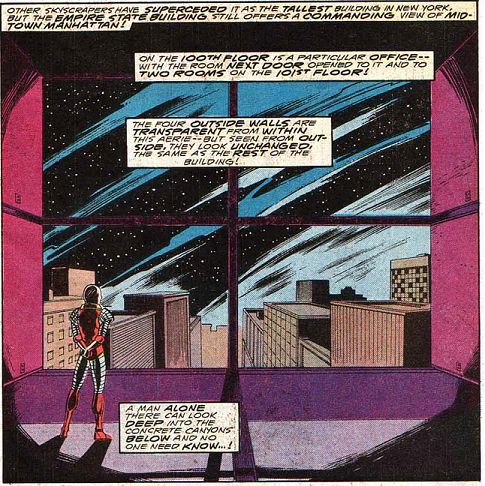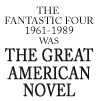







 |
 |
 |
 |
 |
 |
 |
 |


 FF304
annual 20
305
306
307
308
309
310
311
312
313
314
315
316
317
annual 21
318
319
320
321
FF304
annual 20
305
306
307
308
309
310
311
312
313
314
315
316
317
annual 21
318
319
320
321

Summary
Through 1988 the signs became stronger; the cold war was ending. The world was getting better!
At last the struggle is over! Doom is neutralized, Reed decides to finally put Franklin first, and everything else falls into place. All the major dilemmas are resolved according to the four themes:
Like every "well made play" (Google it) the story ends with a reaffirmation of family values: putting Franklin first solves everything! Even Doom is finally neutralized by children (Franklin and Kristoff) in a story about Doom's love for his mother.
This conforms to all the expectations of a fifth act in the classic five act structure: The lovers return and each ends up with their true love (although this is cut short at 321: see the next generation); There is the final push where Ben finally finds his true self and achieves peace; secrets are revealed (hidden themes are acknowledged: that Reed should put Franklin first, Ben must face himself, and Johnny is still in love with Crystal), and there are prizes for everyone (everyone gets their heart's desire, or is on the way to it).
All major character arcs are now resolved: The Mole Man is now a friend; Doom, having abandoned ruling the world as his primary goal, is also neutralized as an existential threat. The Namor, Baxter building and Skrull sub-plots were resolved (or in the case of the Skrulls, moved toward resolution) in Act 4.
All major motifs are present in these final issues of Act 5: monarchs and would-be monarchs (the kingdom of Fasaud); hidden races (many of them are seen in Subterranea); dangerous frontiers (a new team; the Beyonder's universe); mind control (Crystal's affair and Kristoff); doppelgangers (the She-Thing); home (Reed and Sue move out); Reed's health and appearance (now he looks like a scientist, his true self): and the return of pseudo-Biblical language.
For the past few years, the pressure has been relentless. Reed and Sue were in despair, and Ben had given up hope. But finally Reed makes the right decision, to make Franklin his top priority at last. The pressure drops! As with many issues, the title reflects both the particular issue and the long term story.

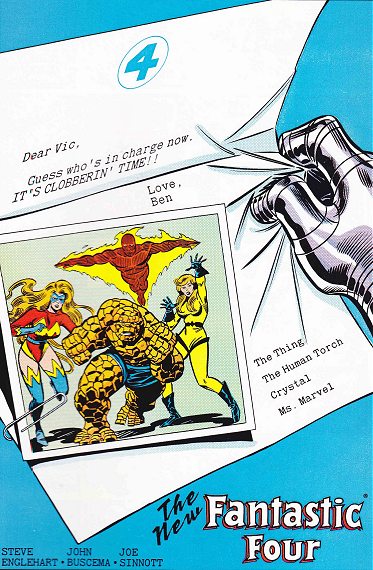
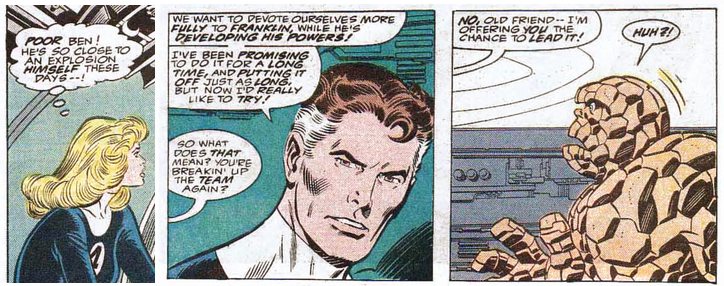
The Thing begins to discover his identity. In FF296 his monster anxiety is finally resolved once and for all. He is at last able to put it behind him. Under Englehart he becomes no longer an outcast but a leader: he replaces Reed Richards as head of the Fantastic Four.
Reed and Sue finally resolve their 28 year conflict of family versus ambition: family wins. In FF307 they leave the day to day running of the FF to Ben, and move out to do what they always promised to do: focus on Franklin. Note that they can never truly leave, they simply step aside to let Ben and Johnny flourish.
Note that Reed has finally learned humility: he spent years ensuring that he was the alpha male, and now he's giving power to his rival, Ben, the one he always treated like a child (e.g. not telling him the truth in FF245) because Ben is genuinely the best man for the job.
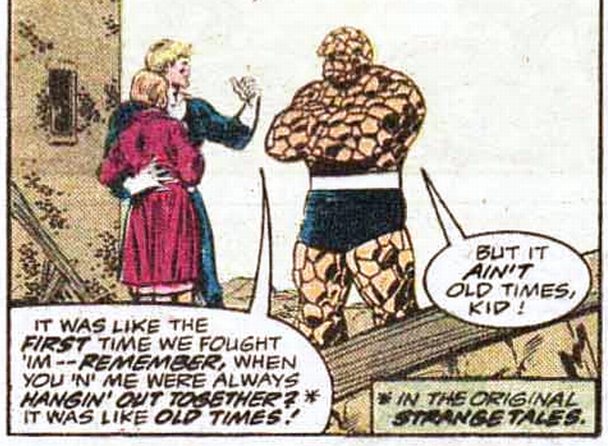
Note the big continuity: they remember Johnny and Ben's adventures in Strange Tales (1962-1963), and they recognize that time has passed and they have grown. It ain't old times, kid!
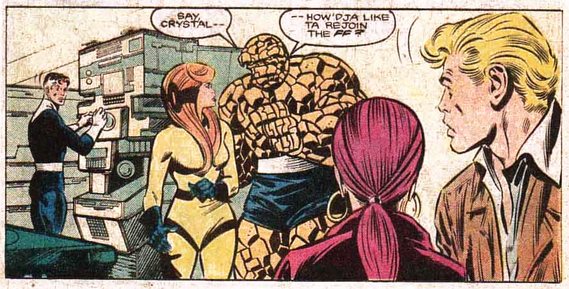
Ben takes over the FF, and begins to be the responsible protector Alicia always wanted. He brings back Crystal, Johnny's true love. The lovers have been out of balance for so many years, and balance is finally on the way back.
The momentous importance of these stories may not be obvious from the cover. As Englehart wrote,
"One thing to note is that the writer has nothing to do with the cover; that's the province of the editor, and shows what he thinks of the book. So even though I started a radical new storyline as per usual, the early covers in this run remain pretty uninspired, even generic."
More about Crystal and Johnny.
Why she matters to the next generation of the Fantastic Four.
Other points to note
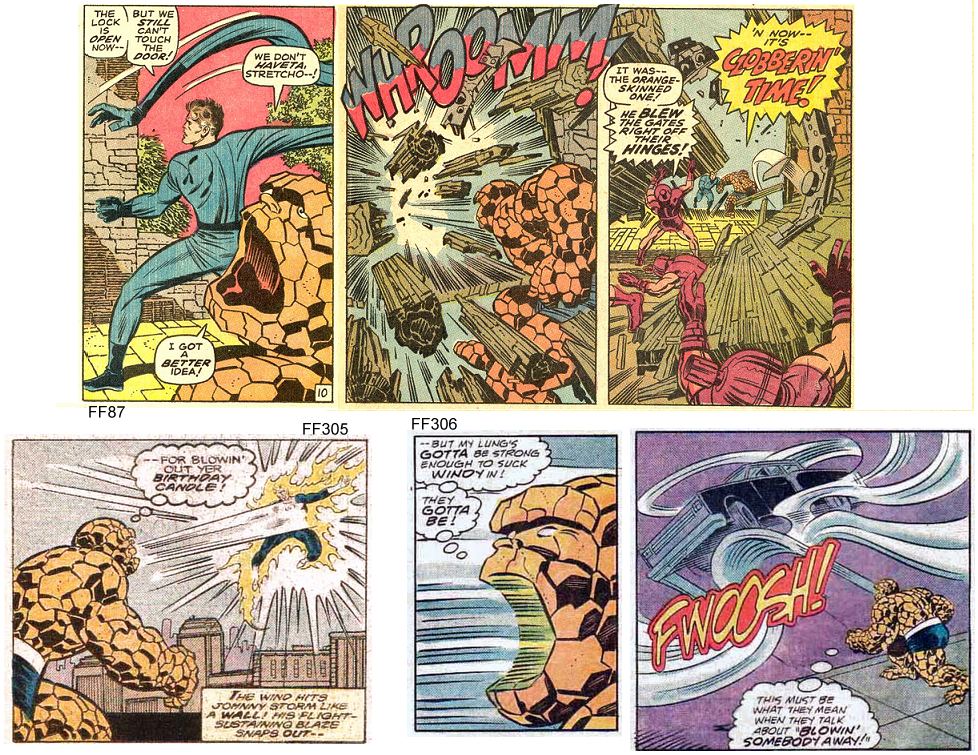
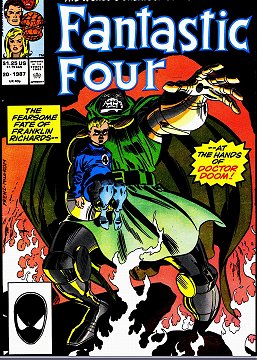
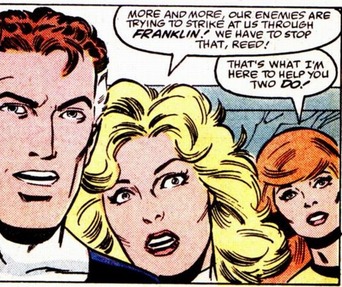
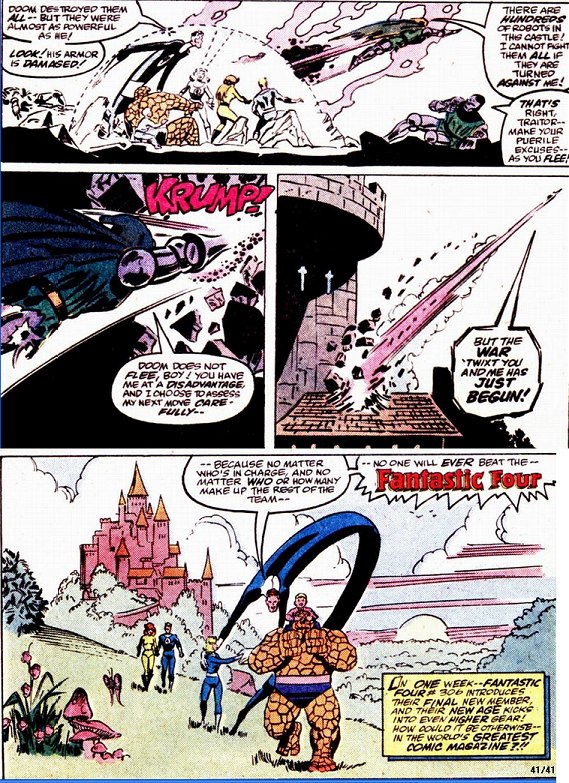
This is the big one, the resolution of Reed's biggest conflict: how can he concentrate on Franklin while Doom is free?
Doom has already mellowed a little, he no longer actively seeks to rule the world, but he is still a loose cannon: and no matter how often you defeat him he comes back, and while he does Reed can never relax. How do you defeat someone like that? Answer: you don't, you keep him busy with an equal and opposite force, Doom 2. Doom 2 has the same brain, and most of the same experience, but he's younger and presumably learns faster. They are equally matched, each devotes his life to defeating the other, and neither will ever be defeated. Stalemate!
Doom will still return - as the major "villain" of the epic story he will dominate the remainder of the final act, but after this he is de-clawed. He still talks the talk, he is still a serious threat, but from now on Ben and the others can handle him. For an overview of Doom's development in all his twenty appearances see his own page.

This new Doom does not get the whole of the old Doom's experience.
This actually makes him stronger: the old Doom made some pretty
bad decisions but could never accept they were wrong. This Doom
does not have those decisions, but has the flexible brain of a
child. he can learn more quickly without all that baggage.
Why Kristoff matters
Kristoff is a good example of how the stories write themselves.
Byrne introduced him as a throw-away bit part character, but then
found the character became more and more important. By the end of
his run he planned a whole year of stories, "Doom War" about Doom
1 versus Doom 2. This would be the first time that Byrne's run had
a whole year on anything. But instead Byrne got an offer from DC
to reboot Superman, so the Doom War epic was never written. But it
underlines that Kristoff has major importance to the Fantastic
Four. (Source: "Comics Creators on Fantastic Four" page 95)
It's is all about families
Note that both Doom and Reed are finally "defeated" by children, and
Doom's story was about his mother. This is a family drama that moves
forward, so this is the only way it could end, with mothers and
fathers usurped by children and a new beginning.
Doom's love for his mother is obsessive
"Doom is a egotistical mad man. He has a severe God complex giving him delusions of grandeur and the idea of followers. While he has been around the Marvel dating pool, with such romances as Scarlet Witch and Valeria. I find that the character has had a one true love of what many people called a disturbing nature. He has such a large ego that it's plain to see that he has a God Complex it does make finding love hard, who could possibly measure up to Doom's standards. From the looks of things, Doom certainly seems to suffer from an Ego Induced Oedipus Complex. For who should be worth of "God's" Love then the Woman who gave him life. A disturbing Idea, Understandably. But It does culminate to a darker truth of Doom's Love for his mother, reaching very unhealthy standards. To see Doom having Romantic love for his mother really puts the idea that Doom is a broken individual. He has literally gone through hell for his mother. It could be an affect of his Mother's early witchcraft that affected Doom. It could be his traumatic childhood. But there is one thing that is plane to see. Doom suffers from a deep sexual attraction and true physical love for his mother. An effect to his psyche that makes him a prototype Bond Villain. Whether that becomes something we as comic book fans accept is an entirely different issue. Sure it's a disturbing Idea, but it's a strongly supportive theory. Comic Book Canon has done much to show this idea without blatantly stating such an insane theory. But this is a long and well thought out and theory." - Robert Garlen
So in the end Doom is neutralized by his family: his mother, and his son
Could Kristoff really defeat Doom?
The simplest explanation is that FF350 was Doom's version of events, and his version of events is always self serving. Doom was never as smart as he believed he was: for proof, see the early Lee-Kirby stories, the early 1970s stories, etc.
Option 2: Yes: as Doom is no longer a madman
In the Emperor Doom, graphic novel it is explicitly shown that Doom has matured. He no longer wants to destroy, or to be sole ruler. He let himself be beaten. Consciously he denies it (as in FF247), but unconsciously he knows: Doom needs others. Annual 20 seems to be Emperor Doom in a nutshell: Doom has moved on. He does not simply crush Kristof as he could: he enjoys the interplay. Whether consciously or unconsciously, he enjoys the personal growth.
Option 3: Yes, Kristoff's mind was younger
Simonson raises a good point: surely Doom would have added a fail safe "off" switch for Kristoff that only he, Doom, would know about? Yes, he would. But look at it from Kristoff's point of view. Kristoff is just as smart as Doom. He will work out at least part of what happened: that the "other" Doom did something to his head. It is true that Kristoff still thinks he is the original, but he knows that his mortal enemy has done something to his mind. So he will not rest until he has worked out what it was, and disabled that weakness. Kristoff's brain is still young and adaptable. He can look at the other Doom's record objectively. And he had plenty of time to think
Option 4: No, it was Pinnochio Doom
"Reverend Meteor" on the comic board, makes some interesting points:
"The Doom who lost to Kristoff was a Doombot that the Beyonder accidentally made real.
"We know the Doom that
swapped minds with Norman McArthur was the Doom that the Beyonder placed
in a new body. We know this is the same Doom that was killed in the
battle between Terrax and Silver Surfer because that's when Doom pulled
the Ovoid mind trick on Norman (how funny would it have been if it was
the Norman Crystal banged) We know that same Doom is the one who lost to
Kristoff. We know that same Doom is the Doom who later confronted
Beyonder to regain the memories he lost so he could be whole to fight
Kristoff. We know this Doom is not the real Doom as the real Doom
reappears in Fantastic Four #350 and it's stated rather emphatically
this Doom never lost to Kristoff...the entire purpose of this retcon was
to keep Doom from losing to Kristoff. So if Doom didn't lose to
Kristoff then Doom didn't confront the Beyonder to get his memories back
to fight Kristoff after losing to him. If the Doom who confronted
Beyonder was a doombot then so was the Doom who was in Norman McArthur's
mind and thus the Beyonder never gave the new body to the real
Doom....he gave it to a Doombot. Meaning that if Doom that was in
Norman's mind was a doombot then ipso facto the guy who was destroyed in
the battle between Terrax and Silver Surfer...must have been a Doombot.
"But how could a Doombot
pull off the Ovoid mind trick? Doom has two things going for him...his
mastery of science and his mastery of magic. Doombots have been able to
fool telepaths and others with heightened senses before. If Doom has a
good enough Doombot it can do everything Doom can do and fool the best.
Even the Beyonder? Yes because the issue Beyonder separates Doom from
Norman shows that the Beyonder isn't good at observation and can't even
tell Doom is in another body.
"Doomochio just swapped out
another Doombot to fight Kristoff in FF #350. The Doom that fought
Kristoff (whether real or originally a Doombot) shouldn't have still
been a Doombot by FF #350 because of the Beyonder giving him a new body
in FF #288."
Option 5: No: it was a Doombot
Walt Simonson did not like the idea that Doom could be defeated by Kristoff. He felt the real Doom would have added a fail safe to quickly defeat Kristoff. So in FF350 that is what happened, and he explains that Kristoff merely defeated a Doombot. But FF350 was soon contradicted by FF358, which explained that Doombots are not that bright. Doom as a Doombot also creates problems for FF288, because the Doom who was afraid of Kristoff was taken by the Beyonder, and he seems to be human. FF350 also has problems when we trace the origin of the shiny new armor: it appeared in an issue of Excalibur, and this does not fit Doom's story that he had been away a very long time.
"Reverend Meteor" notes another problem this causes:
"I think the #350 retcon is kind
of interesting. The purpose of the retcon was to invalidate Doom's
defeat at the hands of Kristoff and for the reader to be able to cherry
pick which Doom appearances they feel are the real Doom and which are
Doombots. I don't think the writer realized that removing Doom's defeat
at the hands of Kristoff sets off a chain reaction that invalidates an
almost 100 FF issue stretch of appearances. All those stories built off
each other and removing the defeat at the hands of Kristoff is like
pulling the wrong piece in a game of Jenga...everything falls apart.
Because like I said if Doom didn't lose to Kristoff then he never got
his memories back from Beyonder to help him defeat Kristoff, he was
never given a new body, was never in Secret Wars, never swapped places
with Norman McArthur in the battle between Terrax and Silver Surfer. A
lot of continuity was tied into to his feud with Kristoff both before
and after his defeat."
Option 6: No, because Kristoff was the original Doom
See the notes to FF 247 for details
Other points to note
Humans are social creatures. Finally, by focusing on friendship rather than technology, the team achieves equality and balance and happiness.

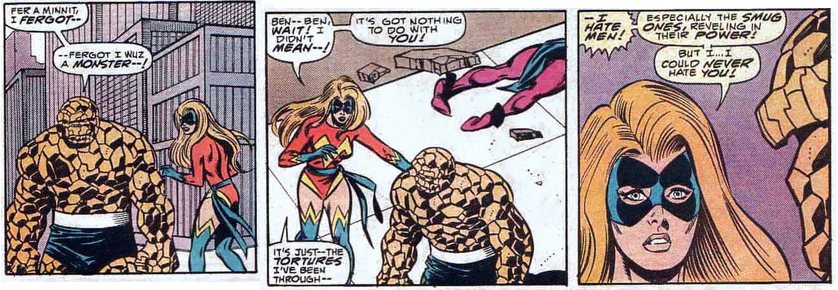
A major theme of the series has been equality. While equality is more than numbers it cannot have escaped notice that Sue was the only woman in the group. True, She-Hulk joined, but it was understood that she was a temporary replacement for a male (Ben) and was not part of the family. But when Sharon joins there is no temporary clause: she is a member of the team for as long as she wants to be.
More importantly, Ben will finally have a healthy relationship with a woman: not fearful, not self hating, not wondering if she only likes him out of pity, but a position of strength and equality. This can only happen by finding someone who has the same fear of commitment that he had, so seeing himself in someone else. This finally allows him to see himself in his true light, and no longer be a "thing," a monster, but a person.
The mental health issue
Here we contrast people with contrasting mental health:
Ms Marvel: severely traumatized by rape, cannot relate to men
Quicksilver: paranoid since childhood, and perhaps with good reason
Reed: he does the best he can, but causes Quicksilver "severe depression"
Diablo, who despises others as beneath him, yet cannot see how pathetic he is, wasting his talent on such futile failures.
Ben and Crystal are more rounded and can see others' points of view: Ben has some sympathy for Quicksilver and Crustal realizes the difficulty her presence creates.
And then there's Lockjaw, the most balanced of all: he quietly succeeds at everything he tries, including catching Quicksilver when nobody else can.
Medusa: a glimpse behind the facade
This issue may reveal a key insight into Medusa and Inhuman politics: Medusa may be doing more than we think. Here it
is Medusa's idea that Crystal joins the FF, and she claims to represent
Black Bolt's thinking. But in annual 20 Black Bolt strongly wants
Crystal to stay with the Inhumans. This is perhaps the clearest evidence
that Medusa does not simply deliver Black Bolt's message, she is the
vital gatekeeper: just as Reed Richards' pliable hair represents his
pliable mind, so Medusa's
pliable hair may reflect her own political skill. It was Medusa who
arranged for Reed and Sue to get back together in FF149, and Medusa who
played both sides at the start, Frightful Four and Fantastic Four.Medusa
may be doing far more than we realize.
Sympathetic magic
To understand Diablo we must understand sympathetic magic: form follows
function; similar things have similar effects and are naturally
connected. As explained in The Golden Bough:
"If we
analyze the principles of thought on which magic is based, they will
probably be found to resolve themselves into two: first, that like
produces like, or that an effect resembles its cause; and, second, that
things which have once been in contact with each other continue to act
on each other at a distance after the physical contact has been severed.
The former principle may be called the Law of Similarity, the latter
the Law of Contact or Contagion. From the first of these principles,
namely the Law of Similarity, the magician infers that he can produce
any effect he desires merely by imitating it: from the second he infers
that whatever he does to a material object will affect equally the
person with whom the object was once in contact, whether it formed part
of his body or not."
Sympathetic magic is the basis for alchemy. It contrasts with the
more powerful forms of magic, such as practised by Dr Strange,
where people call on much higher beings for help. Sympathetic magic is
how the brain works, and how all data compression software works: we
increase our ability to comprehend the world around us by classing
similar concepts together. Sympathetic magic could be the title of FF
306: the story is of how we the team benefits from connections with
others. The team was lost until Ms Marvel saved them. And Ms Marvel only
stuck around because she thinks Ben might be the one man who can
connect to her.
TO BE CONTINUED
Other points to note:
Burning in water
Johnny burns underwater for only the second time in his
career, reflecting his increasing confidence (the last time
was at the height of his confidence as a solo hero in Strange
Tales). This feat has major implications for the science of superheroes.Note
that in the early days Johnny once flamed on when Ben turned the heat
up in the shower: his inability to flame in water is all in the mind.
Lockjaw
Lockjaw shows off his ability by catching the world's fastest
man when nobody else could. If you are not a dyed in the wool
Lockjaw fan yet, there is still
time.
Doppelgangers
The main story involves doppelgangers, a recurring motif.
Crystal
Crystal shows her sensitivity and responsibility. She is
willing to leave the team to avoid hurting Johnny.
Equality
The underlying sexism in the Fantastic Four finally ends: the
team becomes fifty percent female. This will probably
also be the case in the
next generation. But before that when continuity ends
and the Franklinverse
takes over, sexism returns in a big way: Ms Marvel becomes
surplus to requirements, so is turned into a monster, driven
mad, and left to wander the desert. Not Marvel's finest hour.
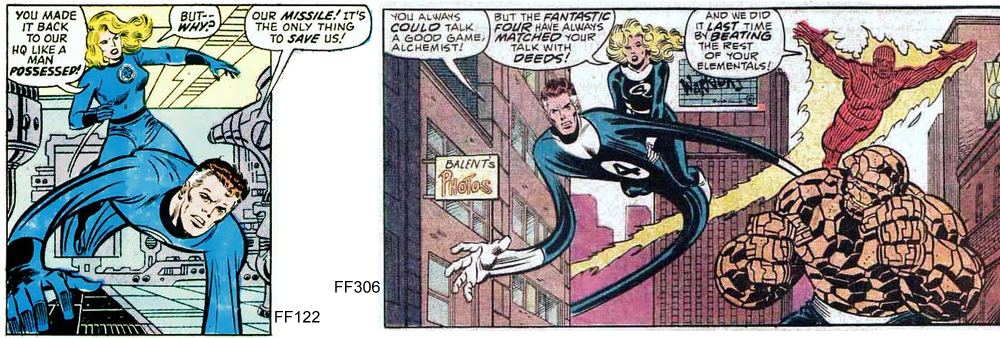
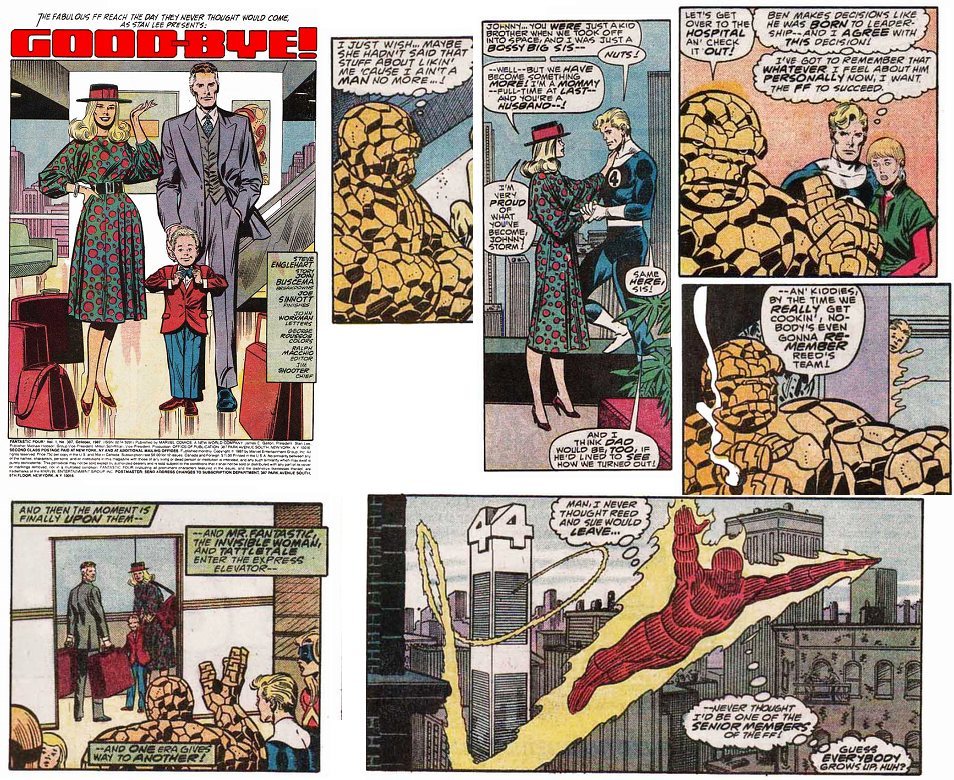
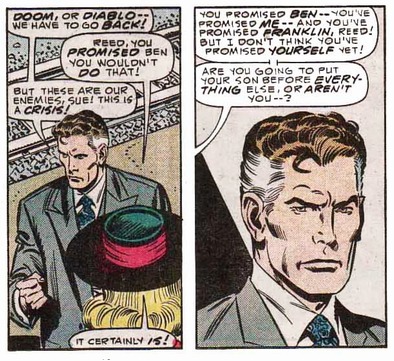
Reed and Sue leave to raise Franklin.
Note the pathos. We have followed this man from the start. He is perhaps the greatest hero ever. He has done more for the world than anybody else (considering the time he's saved it from the biggest threats, plus his inventions). His courage is unquestioned. Those who know him are willing to give their lives for him: his enemies have done so on at least two occasions (FF51, and the Brute). he is the hero's hero, he is beyond any criticism. Yet despite his fantastic, unparalleled abilities, he cannot do what needs to be done. No one man can be that fantastic. The greatest thing he can do is step aside, because he is holding the others back.
It's deep stuff.
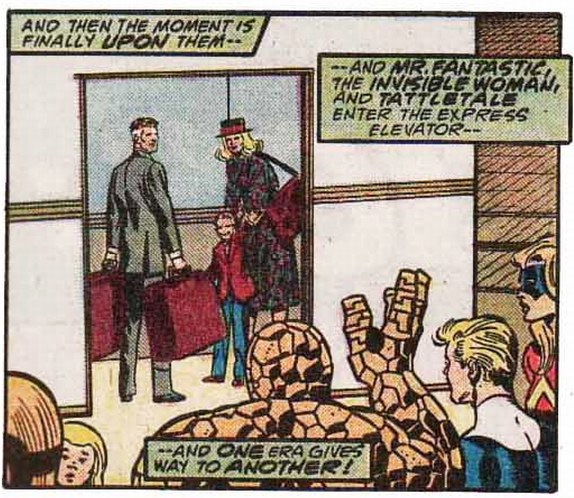
As the story says, one era gives way to another.
Sue's triumph
Note that is was Sue who persuaded Ben to come on the original
rocket ship, and Johnny only came because she was there. Sue
created the Fantastic Four. Without her it would be the Fantastic
One. And now, at the end, it is Sue who persuades Reed to put his
family first. By doing this she saves her whole family:
Respecting others' decisions
This story's theme is the need to value others. We see it both
through Reed letting Ben take over, and in examples of people who do not appreciate others:
Franklin's triumph
The splash page shows Franklin adjusting his bow tie. One fan
commented on the FF message board: "Franklin also has TERRIBLE
fashion sense AND is apparently quite proud of it!"
Personally I think it shows that Franklin has a sense of humor
that's really quite sophisticated.
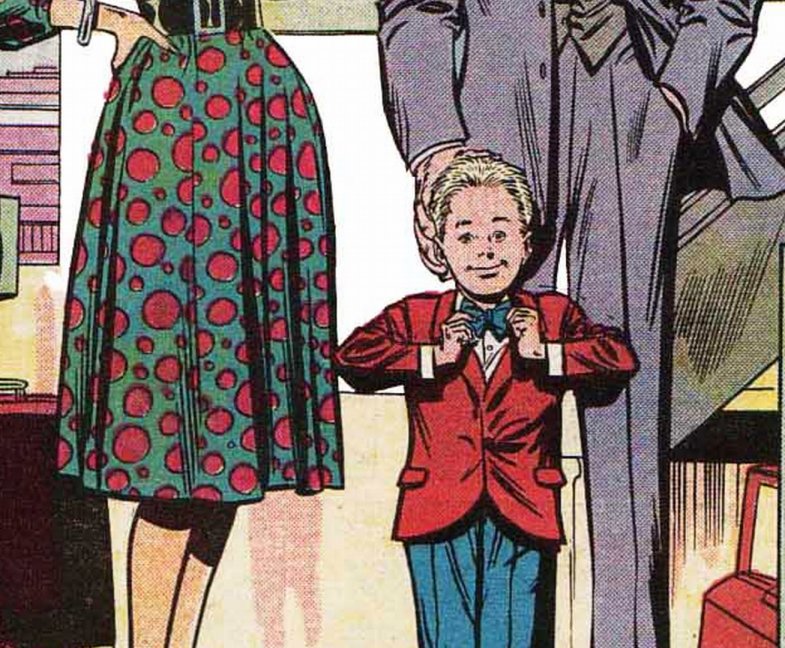
That single image is possibly the most important one since the
cover of FF1. It's the end of the 28 year story, the climax before
they walk into the sunset, when Reed finally puts his family
first. Sue and Franklin have won.
Here's my theory:
in short, this is Franklin's slightly unhinged "I won! I won!" suit. For more evidence, look at their faces:
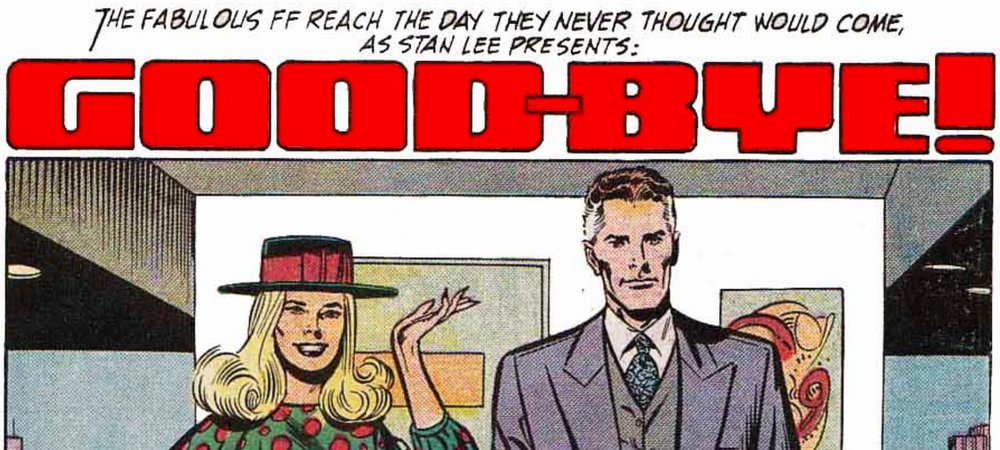
The whole point of this image is a new start: it looks to the
future at last (sad that it took a story about science 28 years to
look to the future!) and this is where the image gets REALLY
interesting. The roles are now reversing. Until now Reed was at
least nominally in charge (and he was completely in charge until
the half way point, FF159, in my opinion). Until now we could
always see Sue as the Cassandra character, the innocent who was
always right yet always ignored (hence the name invisible). but
now it switches. Sue is officially in charge now, s the buck stops
with her. There are no excuses. She is about to discover how hard
it was for Reed.
What happens next
In the next few months Sue will find herself out of her depth just
as Reed was. Instead of the happy family that learns Franklin's
abilities, she will default to the easy option, just middle
American family, and within a month they will accept a job with
the Avengers and slide right back into putting Franklin second.
Because Sue is an imperfect parent, just as Reed is. Neither of
them had their parents around in their formative years. Neither of
them really knows how to bring up kids.
Now let's look beyond the next couple of months (where Sue begins
to flounder), to the next year when Reed regains control. The key
issue is FF319, where Doom takes Ben's team to meet the Beyonder.
At the start Reed catches a glimpse of Doom and Ben in their ship
as they jump between realities.
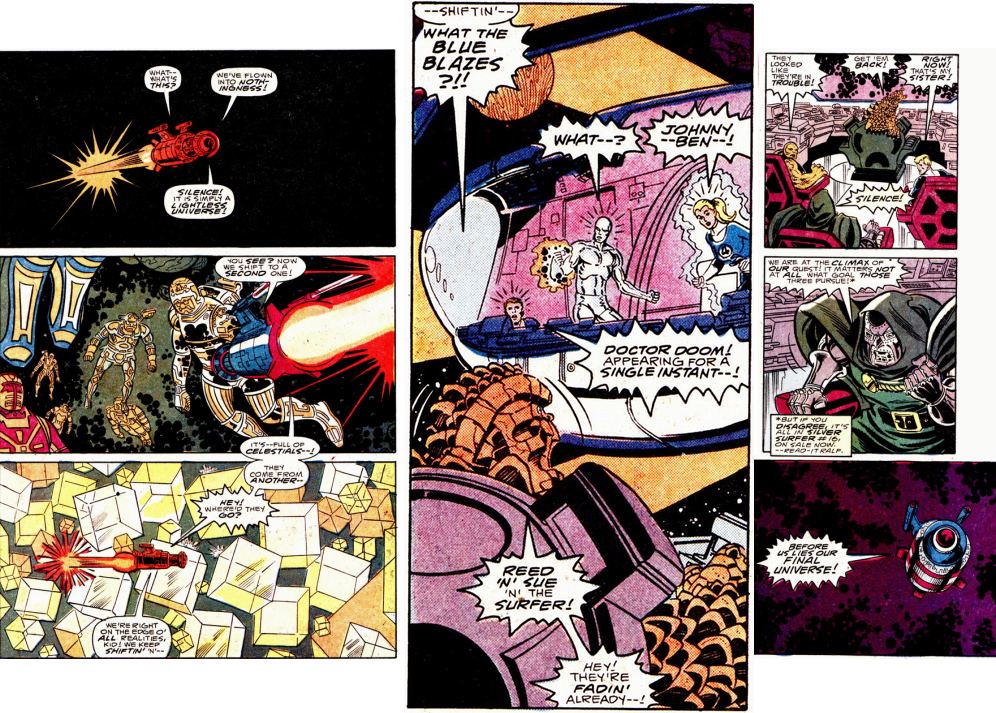
We should never underestimate Reed's brain when it comes to the
physics of other dimensions, or his rivalry with Doom. Although
that was just a split second image its significance would not be
lost on Reed and he would pick up the details later. That moment
is a massive turning point for Reed. I believe that is when Reed
unconsciously knew he had to go back. It was no coincidence:
Franklin beat Reed, so Reed learns to be more like Franklin
The F319 journey is the first time we see Reed do the "astride
multiple realities" thing. Until that point he had often sometimes
jumped between realities one at a time (e.g. to the negative zone
or the fifth dimension) but had never flicked between realities
like flipping the pages of a book. That reality flipping became
the signature for the Franklinverse period. It happens again and
again from this point: notably at the end of Simonson's run, the
end of Claremont's run, the end of Millar's run, the end of
Hickman's run, and numerous other times. It's pure Franklinverse.
It's the "between realities" life that Franklin experiences
semi-consciously all the time.
FF319 is when Reed decides to loop back on his own timeline. It
leads to FF326 where Reed comes back to the team, ending the
linear progress his lie had taken to that point. This is
exemplified by the next story arc (321-333) where we see an
alternate team starting again. Sue, doppelgangers have been a
theme since issue 2, but this is the first time Reed goes back to
retread his old life again: I believe this is the first time that
Reed embraces being multiple Reeds at once. Reed is becoming more
like Franklin: a multidimensional layered timeline, straddling
more than one reality at once. Normal chronology (one person
moving forwards in time) ends at this point.
This eventually leads to the "council of Reeds" that we see evolve
from the Dark Raider story, the Ben's skin story and climaxing on
Hickman's run. Reed is like Franklin:a multi dimensional being.
Sure, the other Reeds are in theory separate people, but the fact
that they evolve to look and act so similar indicates some kind
blurred links between realities. Reed is learning Franklin's
dream-world rules.
Doom's role in the end of the FF
Note how Doom, like Reed, is in a state of flux at this point
(FF304-321): Reed could only step down while Doom, like Reed, was
defeated by his own son. In FF311 we see Doom, like Reed, forced
to play second fiddle to someone else. Doom returns to play a
central role in FF319, foreshadowing the whole Franklinverse
meta-arc, where the Celestial links Doom and Reed, Doom connects
with Val, "all hope lies in Doom", etc. Doom's use of magic makes
him more comfortable with the Franklinverse multi reality
layering, and Doom at his best totally understands the idea of a
leader's duty to the younger generation. In my opinion neither
Doom nor Reed can be complete until they recognize each other as
two sides of the same coin. FF319's Molecule Man and Beyonder work
as a metaphor for Reed and Doom. Note the role of the Molecule Man
and Doom in breaking up the team int he previous false dawn,
FF188-200.
tl;dr: that bow tie picture is worth a thousand words.
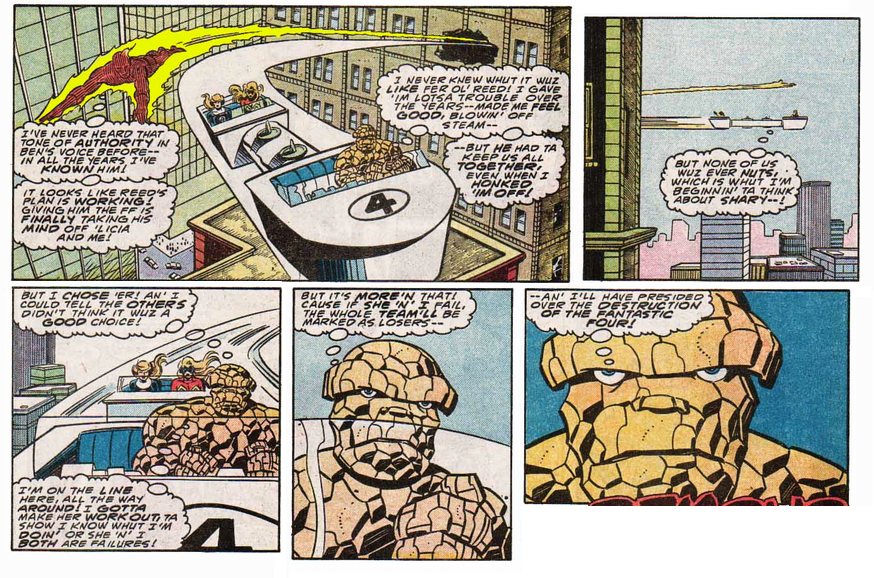
A large part of the Fantastic Four was Reed's attempts to cure Ben. But the problem was never his rocky exterior. He was the idol of millions, and the last time that Reed's influence waned, he was desired by both the most confident of all women, Thundra, and the sexiest, the were-woman Tigra. Even near the start, when he was lumpy, women admired him (e.g. in issue 17).
Ben's appearance was never the problem. The problem was Reed, who (unintentionally) gradually destroyed Ben's confidence. Now that the old confidence is back, and with added responsibility, the one thing he lacked in issue 1.
Remember that Ben never actually wanted to be a superhero, but there are three who love being members: Reed, Crystal, and Franklin. So this interregnum period will only last until the last member of the new team is ready: until Reed and Sue have learned the extent of Franklin's powers, and he is ready to take his rightful place in the team. Reed said he could join in a couple of years, and that was one year ago (Marvel Time), leaving one year for them to prove they love him and understand his powers, during which time Ben, Sharon, Alicia, Johnny and Crystal work out their issues. And Reed has to come to terms with the new status quo.
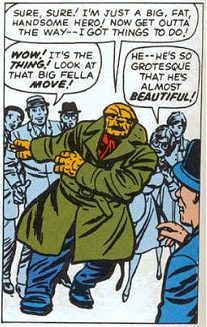
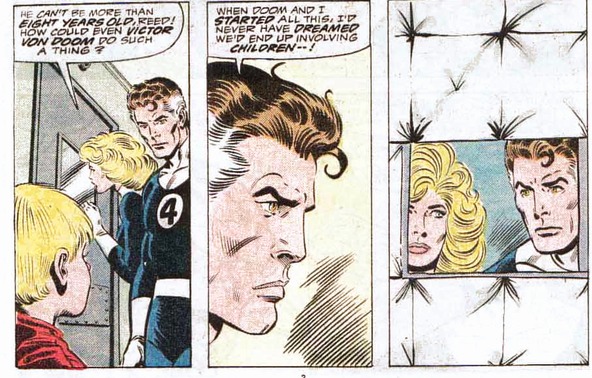
Face facts, Reed. You've been defeated by a child (your duty to Franklin), just as Doom was defeated by a child (Kristoff). It's a new generation, Reed, and it belongs to the young.
Fasaud is the zeitgeist
America's main challenge is no longer communism but its own
divisions (Johnny versus the Thing), but it needs an external
enemy, hence Fasaud. Fasaud is the arc that a lot of people hate,
but its only crime was being ahead of its time. As the Great
American Novel, a story straight from the zeitgeist, the great new
villain has to be
Fasaud:
He represents the rise of cable TV
He represents the Internet (see comments on next issue)
He represents middle eastern terrorism: like the reds under the bed scare, terrorists can be anywhere, like Fasaud
He represents the geopolitics of oil (note Sharon's comments next issue)
He represents the shift from Russia to the middle east as the source of America's fears.
Had Englehart waited three years until the pressure built into
the first Gulf War, the story would have been seen as highly
relevant. The Fantastic Four was so in tune with the national mood
that it identifies themes before most people are aware of them.
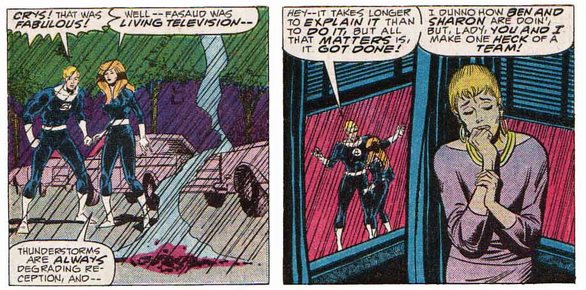
In this issue, Crystal really was fabulous. And she said she wants a life of action. She was in the team in their happiest and most exciting time: like Johnny and Franklin (and unlike Ben, Reed and Sue) she really enjoys this, she's made for the team.
Meanwhile, Alicia describes how Johnny and she fell in love. But what she describes is not love but friendship. And what she needs is not Johnny, but a protector who won't leave her as Ben did before he found himself.
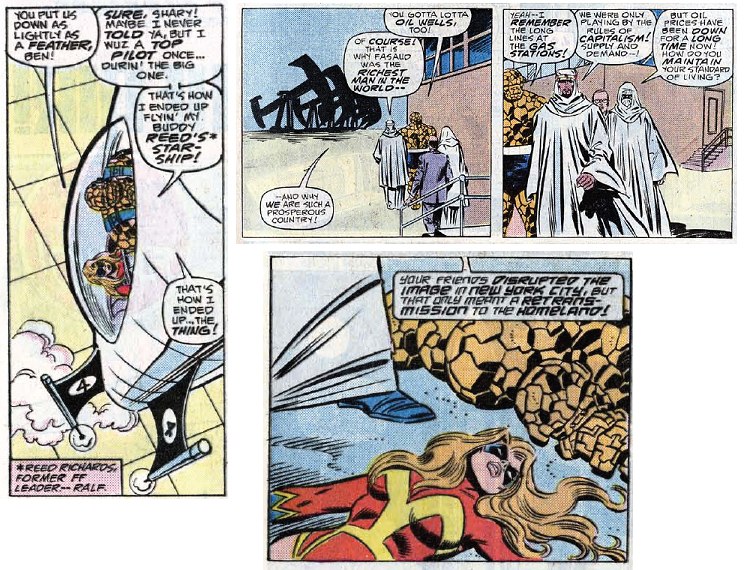
Other points to note:
The zeitgeist: big oil (this was the time of the Dallas TV soap opera) and the politics of oil prices
Fasaud is said to be based on TV, but is more like the Internet: he isn't broadcast, he just routes himself to the one place he's needed, using any available technology, and he routes around damage (the whole point of the Internet: like Fasaud, the Internet was a military invention. The Internet in 1987 was in its very earliest days, before the World Wide Web made graphics and avatars ubiquitous.
Note that this is still the original team: Ben refers to flying in "the big one": he fought in World War II. But in 12 issues' time continuity will end. Walt Simonson will celebrate the end of continuity in his run, and at the end (FF354) the characters will be quietly rebooted (see the icon at the top of this web site that represents the Franklinverse: Ben changes). The Franklinverse characters are different people. The 1988 Thing fought in World War II, but the 1990s Thing was not even born in the early 1960s:
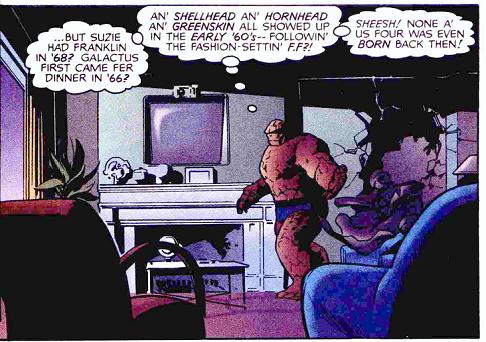
At the top of the page we saw how the story is resolved in terms of the four major themes. But that was superficial, merely showing examples of those themes (they get what they want, Doom was defeated by a child, etc.) But that does not resolve the underlying causes of those themes, so the play is not yet over.
The second half of act 5 shows the themes themselves are resolved in a deeper, underlying way as well. This is necessary for a truly satisfying and final end. After this there will be no more doubts over their desire, confidence, equality, or achievements: these troubles can never again arise. Sure, the friends will still have battles to fight, but we know they will always be happy and at peace, and more than able to solve whatever problems come at them. So we can have a big "THE END" sign as the team rides into the sunset. After this we will need a new team with a new set of conflicts, otherwise the stories would become dull.
This is how they finally solve the underlying problems of...
Reluctance: Ben was never happy (deep down) because he did not want his life. By seeing this at its most extreme (Sharon wanting to die) he finally accepts that his life is not so bad. In fact he finally gets the two things he always felt were denied him: self esteem and sexual magnetism. And now he knows that they come from inside so he an always have them whenever he wants. Sharon will also embrace her role. The other two (Johnny and Crystal) were never reluctant in the first place.
Self confidence: Their success always depended on their confidence. Again, Sharon shows this at its most extreme. The seeds of her cure are sown by the most confident man on the planet, Doom. Ben's confidence is assured by seeing his own repeated success against their greatest enemy, Doom. He can never doubt again. Meanwhile, Johnny is gradually making his life's greatest decision, as you can only be confident when you know what you want! Johnny always had self doubts after Crystal left him, and Crystal's return will solve these once and for all.
Equality: The team is now equal (Ben does not claim superiority) but equality also referred to how they treat enemies. The secret to ultimate success was always Sue's method, to see enemies as people, just like us, and not as one dimensional evil. Since Doom will continue to return (albeit weakened by Kristoff) the solution is to understand him. In the remainder of Act 5 we see Doom as a rounded person, with the concerns of monarchy, with insecurities and weaknesses, and able to good as well as evil (albeit for selfish reasons). Each of these provides an angle with which to neutralize some future threat.The American Dream: Here
the team finally gets everything it ever wanted - Ben even defeats
the Hulk! And in issue 319 they see the folly in wanting more and
more, so they are now at peace. In issue 310 we also see the
limits of the American government (the only time this has ever
happened in the 28 year history). So the dream is over, but in a
good and healthy way.
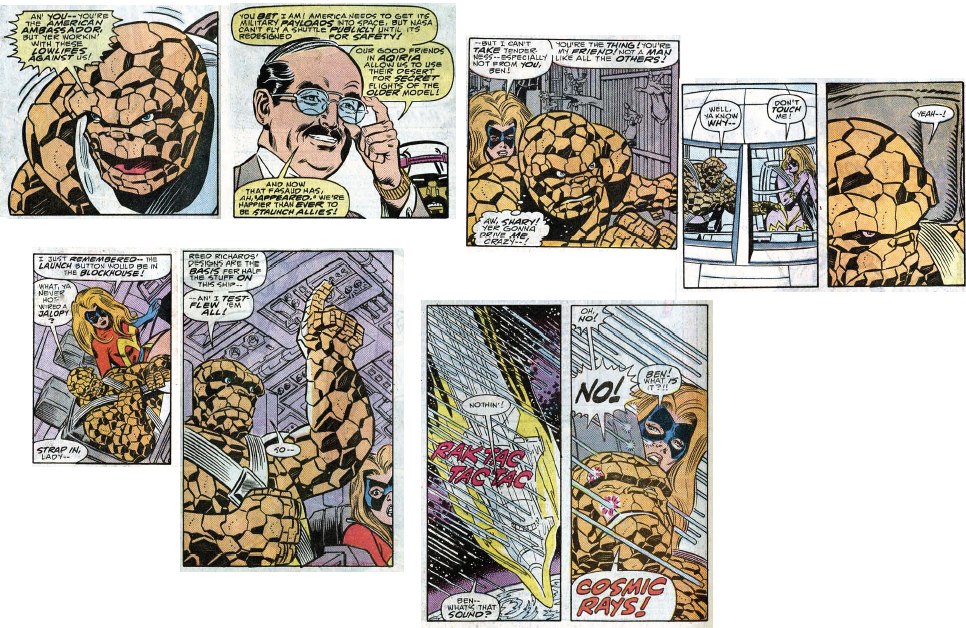
Ben now has his confidence. Now he needs perspective and to learn to love. He gains perspective by seeing another person who is just like he was.
Ben in the past was always afraid to commit (Alicia always wanted to marry, and Ben made excuses). Now Sharon won't let Ben get close, and now Ben knows how Alicia must have felt for all those years.
Ben hated himself and blamed the one who took him into space... and now Ben knows how Reed felt.
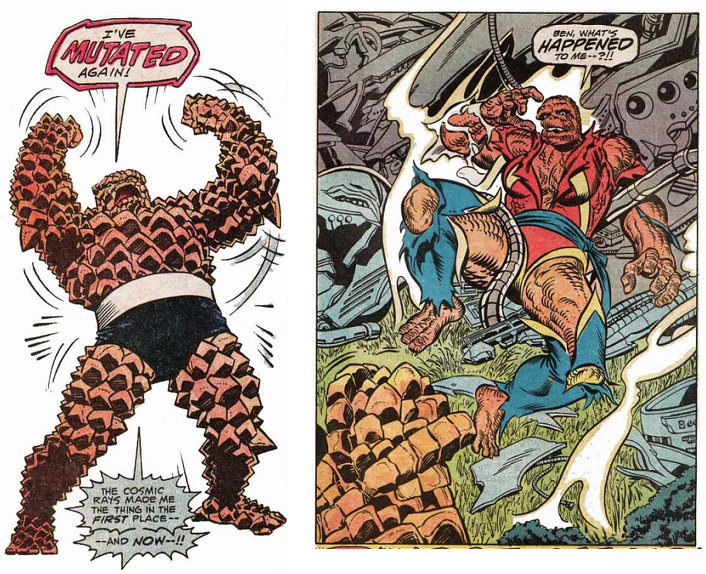
The Zeitgeist
Possible criticisms?
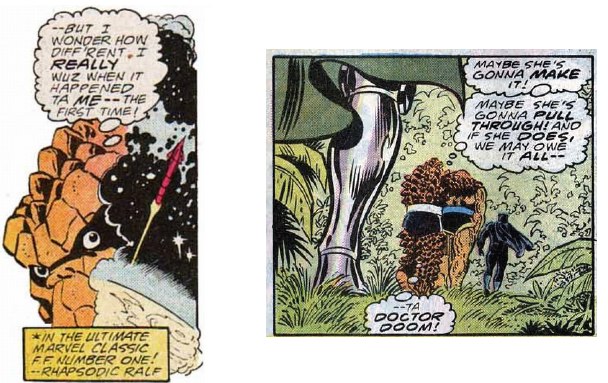
Ben continues his self discovery, seeing Sharon go through all the depression that he did. Note the contrast with Reed. Reed in the early days had no sympathy with Ben, and ended up knocking Ben's self confidence. But Ben is a better leader and builds Sharon up.
This issue is clearly intended as a lead into a bigger story featuring Dr Doom (note that Doom in his armor and hating his appearance is a mirror of the old Ben), but then editorial stepped in and demanded a crossover with a new book, X-Factor. So the story didn't make a lot of sense. (Warning! Editorial interference!) But we still get some interesting touches:
We see that a Thing body cannot be harmed by a large jump, despite what Ben used to think (for more about why the Hulk jumps and Ben does not, click here).
Doom is able to save Sharon when Ben could not. Not with some silly invention, but by building her up: Doom has genuine talents and does genuine good as well as evil. Sure, he wanted Sharon for selfish ends, yet he still genuinely helped her with his wisdom. Contrast this with the two dimensional Doom of the Franklinverse, pure evil (under Waid) or impossibly intelligent (under Simonson): both good stories, but without the realism of a Doom who has weaknesses, good as well as bad, a breadth of techniques beyond magic and gadgets, and genuine nobility.
We see that Crystal is loyal. She realizes that her relationship with Norman was a bad mistake (unknown to her she was mind-controlled), but when she promises something she means it, and she is ready to make it work. But Norman rejects her. Some people interpret this as Crystal still cheating on Pietro, but the marriage with Pietro is over: any western court would have granted a divorce based on his neglect, and on her affair (since mind control is probably not a legal defense). Therefore at this point her only duty is to Norman, and she fulfills it, even though her celebrity status means she could have her pick of men. But once she says something she sticks to it (unless she is mind controlled, or the other person rejects her, as Quicksilver did when he heard of the affair.)
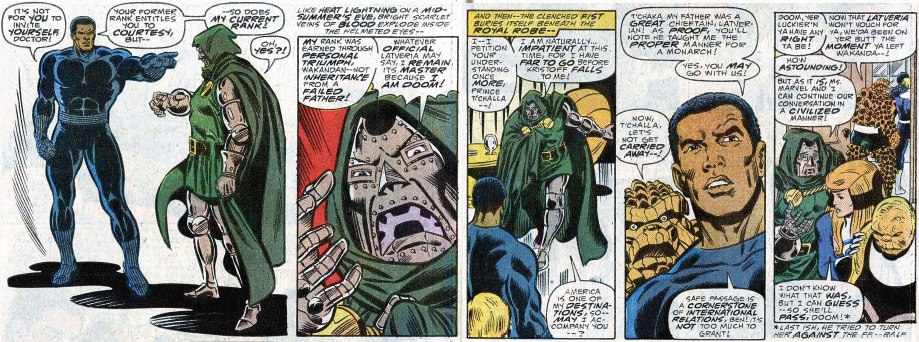
The Doom and T'Challa sequence is Shakespearean in its beauty and understanding of monarchy. If any reader wishes to translate it into iambic pentameter, feel free. The rest of the story had a crossover forced upon it (foreshadowing the end of continuity with FF322) so the story does not develop as well as it might.
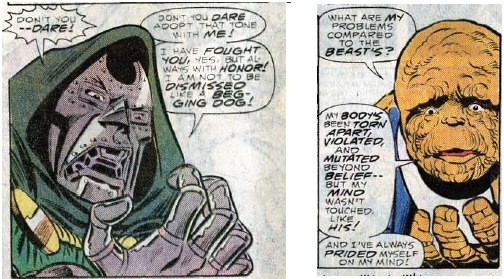
But the real point of this issue is self knowledge. Ben sees himself more clearly by seeing Sharon. Sharon sees herself more clearly by seeing the Beast.
Self knowledge: Ben achieves what Reed never could
In this issue we see that the new team is more mature than
the old team: Ben has self knowledge, and Reed never achieved
that. This is why it took a very long fourth act for Reed to learn
what Ben learns in just a few issues.
Literary quality
"This issue contains powerful
characterization. Englehart says, 'by showing Sharon’s reaction and
Ben’s reaction to it, we learned new stuff about him. It had always been
a given that turning into a Thing was a terrible curse a noble man had
to live with—and now, here’s a noble woman who was taking refuge in it.
That blew [Ben’s] mind because it upset his long-held sense of who he
was.'” (- "Back Issue" 74)
Three dimensional Doom
Doom is in a position where for once he is the weak party. He should learn, but he won't. He should learn of himself by comparing Kristoff and Rees, but Doom is incapable of objectivity or humility, and that is why he always fails, because he tries to do it all himself. Reed was the same: he failed to make better use of the team because he could not see himself in Doom, his own tendency to want to control everything.
This imperfect Doom really bugs a lot of comic fans. One fan called FF312 "one of the few issues I have rated worth burning." This may be partly because Englehart was forced to add a cross-over that harmed the story but mainly it's because Doom shows weakness. This is what sets great writing, like Shakespeare apart from bad comic books: the greatest characters do have character flaws. Note the skill in Englehart's approach: Doom is a natural leader, and he is at his weakest when separated from his people. His absolute lowest point was when his vanity caused him to choose to neglect his people in the early 1970s (when struggling to cope with the loss of the power cosmic), as memorably shown in the Englehart's still shocking Super Villain Team Up series.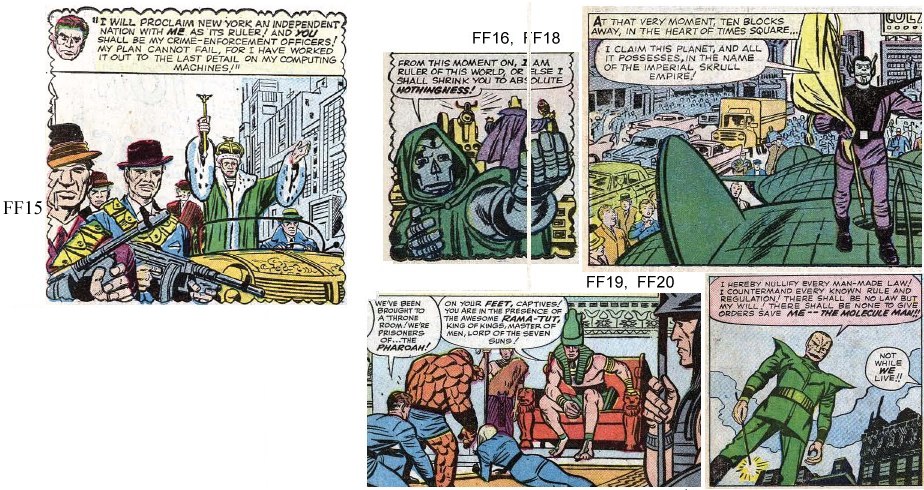
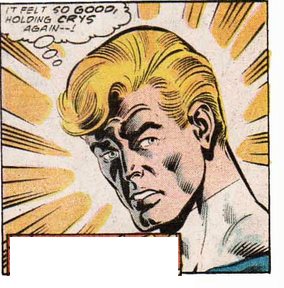
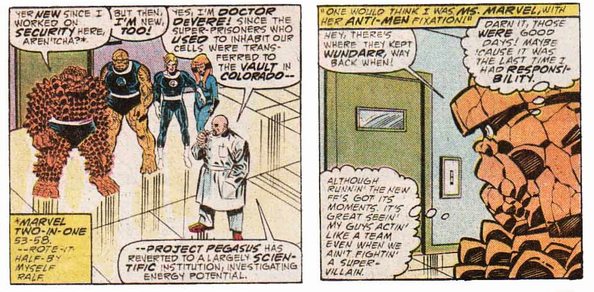
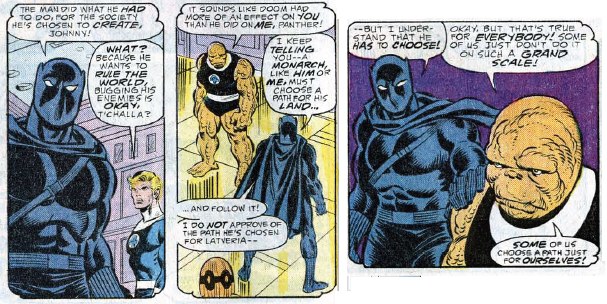
Issue 313 brings an emotional resolution to the FF's first
enemy, the Mole Man - focusing on his
core identity, loneliness. It also begins the final
resolution of Johnny's twenty five year "will they - won't they"
relationship with Crystal. (25 years publication time; 9 years in
Marvel Time, with half of that being before they split up.) Note
that Alicia had already made the Mole Man into a friend in annual 13,
but rather than forming an alliance Reed had abandoned him and the good
was later undone when the surface world attacked him.
Project Pegasus
Project Pegasus is Reed's destiny: the man who wanted to fly (like
the winged horse of mythology) will eventually end up with his feet on
the ground: like a true scientist he will learn the most that way. See the Next Generation for details.
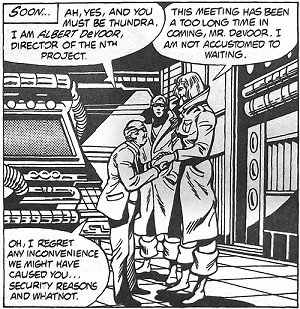
As for DeVoor (or DeVere), this is the name of the man who tried to
buy the Fantastic Four in FF163, and of the villain of the Project
Pegasus saga in Marvel Two In One. The name deVore or deVere comes from
the Norman conquest of Britain. The deVere family so successful in
defeating the nation of Britain that they were given huge amounts of the
land. The deVeres think big.
Other points to note

The Mole Man in context
For how the Mole Man's ten appearances reflect racism and the underground in America, see the notes to issue 1.

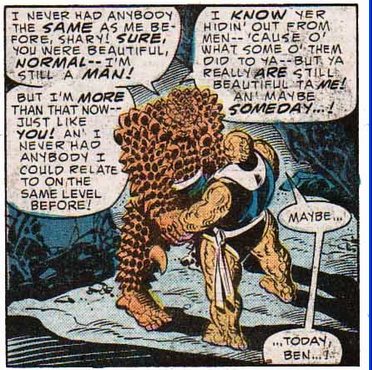
As with Ben, her problem was not her appearance, but her confidence.
Here she works through her confidence. The underground symbolizes her inner state, just as her rocky skin symbolizes her self hatred and search for a stable identity. (For more on the symbolism of rocky skin see the notes to issue 1.)For more about the symbolism of underground rivers in psychology and
myth, see "Underground Rivers" by Richard J. Heggen (searchable via
Google books)

Other points to note
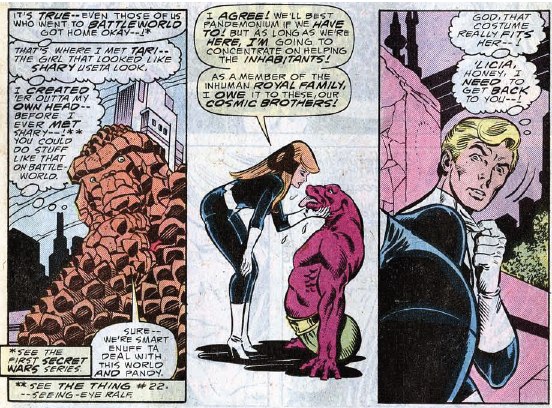
In this issue we see why Ben will end up with Alicia, and Johnny will end up with Crystal.
Johnny was always in love with Crystal. The lack of passion in his relationship with Alicia (I said passion, not sex) confirms what was clear at the time: Johnny and Alicia both married on the rebound. (Alicia had given up hope with Ben, and Johnny had finally given up hope of true love after Frankie left him).
While Ben's creation of Tari may seem proof that he is fated to be with Sharon, it actually shows the opposite: Tari was temporary, an illusion. Ben needed to know that he could succeed with a stereotypical curvy blond, to get past his self doubts. Sharon provides that, while at the same time Sharon needs to know that not all men are evil. They help each other because they both have temporary needs, but when those needs are resolved then they mature and become different people: they both become whole. The basis of their relationship was always their problems. Ben and Sharon will always love each other as friends, but there is no long term bond between them. Note the parallels with FF319, about becoming complete, whole people, then moving on.
Other points to note:
This and issue 319 finally explains everything: this gives us the history of the world, and 319 gives us the higher powers behind it all.
This issues does not merely explain big Marvel history, it hints at the much bigger story that's behind everything. Issue 319 will reveal that higher powers (what we call highly advanced beings, or magic) are behind all humanity and all superheroes. From time to time we get hints, and more than hints: with Nicholas Scratch, or the Sphinx, or the tension between the Watcher and Galactus, etc. See the notes to Galactus' first appearance for more details.between them we can piece together Earth's history (some details from Uatu's List):| 200 million BC | Nuwali (working for Beyonders) created the Savage Land |
| (same time) |
Beyonders plant colonizers on Planet Fortisque, around Arcturus |
| 50 million BC | Continents separate, Nuwali install heaters under Antarctic |
| 1 million BC |
Origins of Kree-Skrull war, Cotati, blue areas of the moon,etc See the notes to FF323 |
| 500,000 BC | FF221: Primus explores Earth: magnetic poles flip. 500,000-40,000 BC: Odin founds the Asgardian gods. (Journey into Mystery 103, Thor annual 3). For the links, see the notes to FF224. |
| 200,000 BC | Homo Sapiens evolve; Nuwali leave For details of the three main races on Earth, see the Eternals by Jack Kirby. 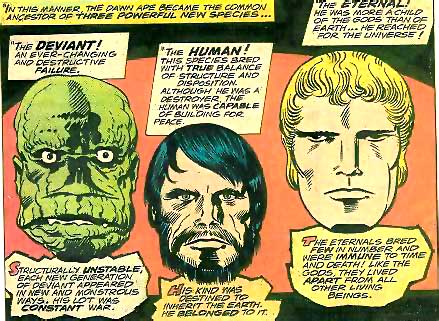 |
| 25,000 BC |
Kree visitors discover Earth's three races. They create a new experimental race: the Inhumans |
| 18,500 BC |
King Kull rules Atlantis: now
still barbaric, but later becomes advanced. This is an ear where higher
beings (magic) were less hidden. |
| 15,000 BC | Height of Atlantis |
| 12,000 BC |
On Earth: the Hyborean age of Conan. On Arcturus (the demon world of FF315): caretakers from Fortisque leave. |
| 10,000 BC |
Deviants (on Lemuria) defeat Atlantis. Celestials destroy Lemuria: huge global cataclysm (heating ends, Savage Land sinks, etc.) Deviants and old Atlantis sink under the Earth: the origin of the Mole Man technology. See FF127. Fortisquans told (by their unknown masters, the Beyonders) to preserve the Savage Land as an animal reserve Fortisquans discover teleportation technology |
| 1,400 BC |
The Sphinx, contemporary with Moses |
| AD 1961 |
The Fantastic Four gain their powers |
| AD 3000 |
Kang the Conqueror grows up (see FF19) |
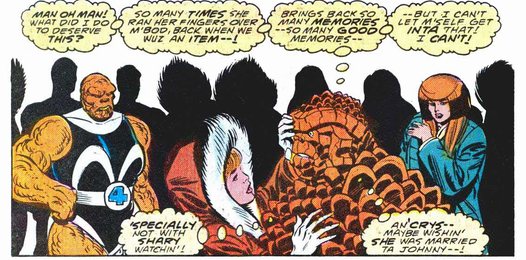
Real world science
...although, given that Alicia is more important than people tend to
think, maybe this is big as well. Note that Ben is friends with the Mole
Man's people and looks like a Deviant. So Human, Ben and Inhuman
(Crystal) represent three species of humanity. This reminds us of the
real world pre-history of man, where homo sapiens were just one of many
hominid species, but the Sapiens wiped out the rest.
Other points to note
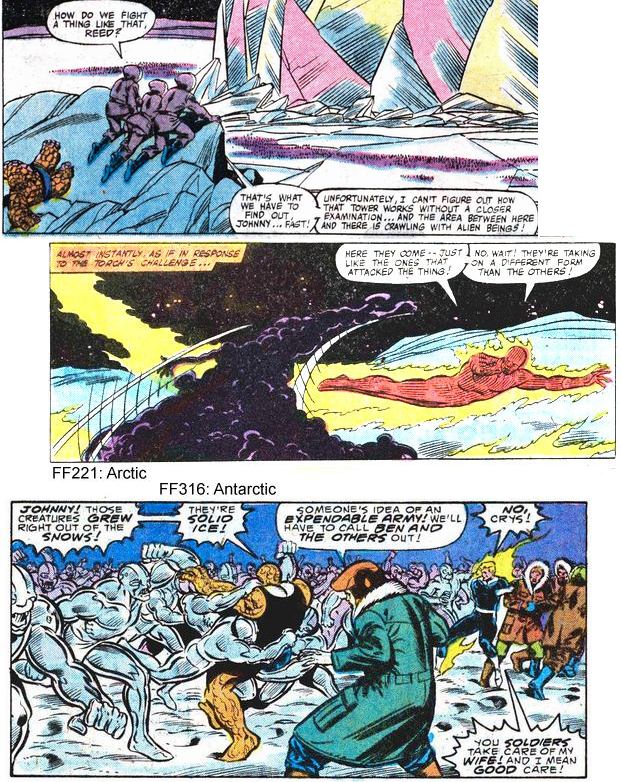
| Issue 222 |
Issue 316 |
| arctic |
antarctic |
| protected by semi-mindless ice creatures (black) |
protected by semi-mindless ice creatures (white) |
| went there to solve a global mystery |
went there to solve a global mystery |
| an underground alien civilization from thousands of years before |
an underground alien civilization from thousands of years before |
| machines that caused global catastrophe (through swapping the magnetic poles) |
machines that caused global catastrophe (through turning off massive heaters) |
For how everything connects, see the notes to issue 224 (regarding Odin and 500,000 BC).
Completing the story that began with Galactus
The cover reminds us that this is the end of the story that began
with FF47. Issue 47 is where the FF discovered the secret of the
Inhumans, which alerted Galactus, and brought planet Earth into contact with the forbidden secrets of the highest cosmic beings.
This issue is where we finally begin to learn what those secrets mean.
The four issues 47-50 are equivalent to the four issues 316-319.
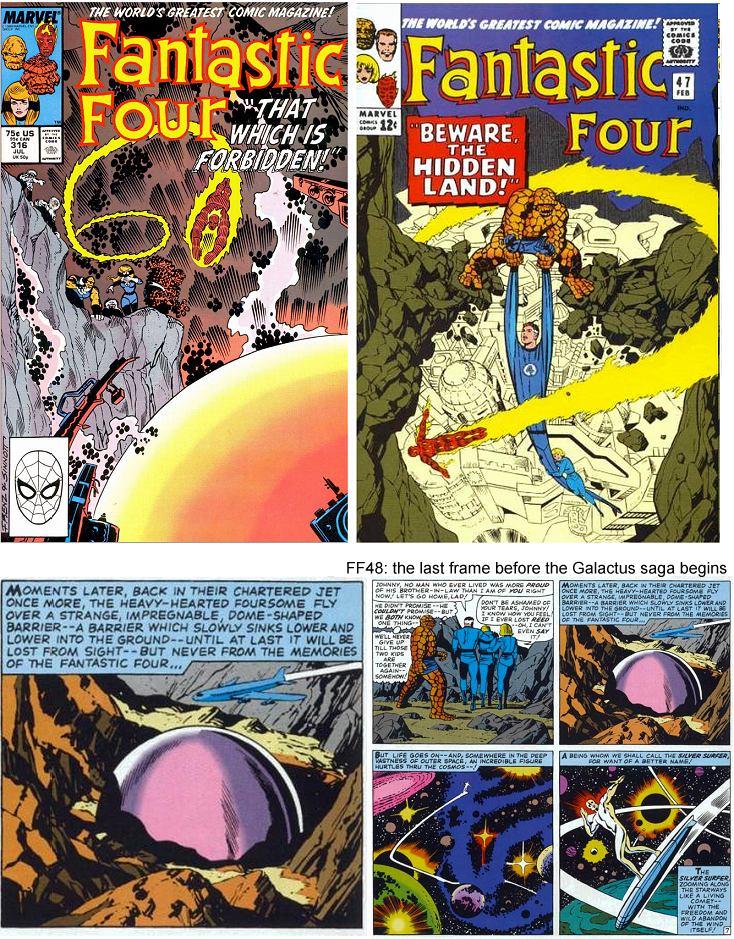
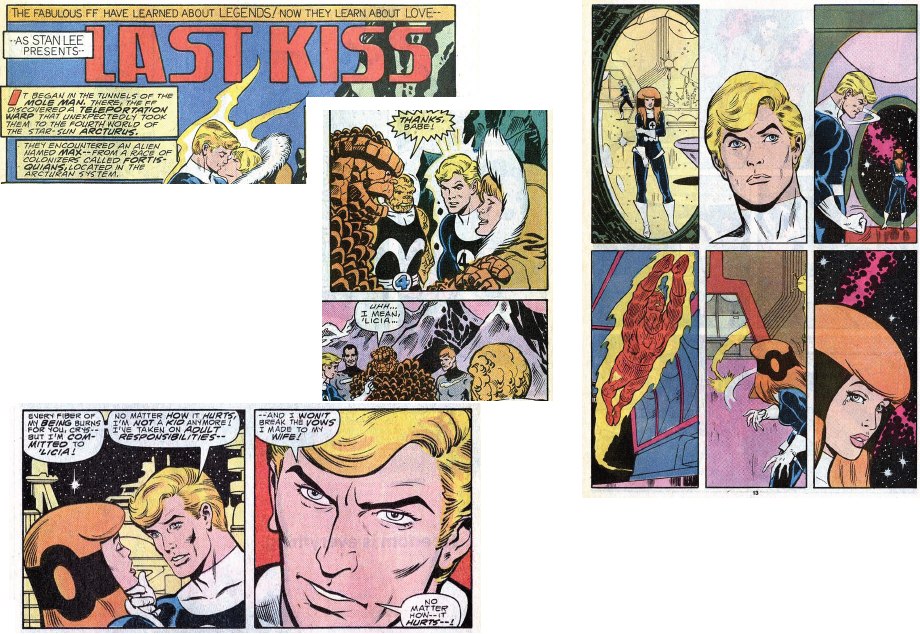
As the start of a new era, these issues fill us in on a whole lot of Marvel history and geography, plus revealing a few more details (like the easy way to travel - the idea of walking between caves and planets really appeals to me. I'm a sucker for that stuff, seeing how all the star systems and races fit together. There's even a miniature version of the Negative Zone!) But the real purpose of this issue is to show that Johnny really loves Crystal, but he's too much of a hero to abandon his wife. Note that there is never passion for Alicia, he just has to tell himself that he loves here. Whereas for Crystal, every fiber of his being burns. Twice he repeats how much it hurts to stay with Alicia when Crystal is there.
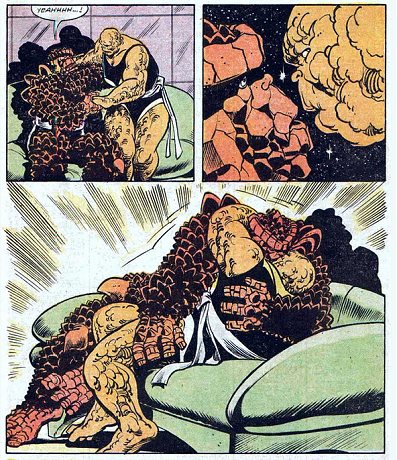
As for Ben, everyone remembers this famous kissing scene, but we tend to forget the context: this happened because Ben had just let his guard down with Alicia, showing how happy he was to see her, and now Ben wants to prove to Sharon that, no, he isn't secretly wanting Alicia, honest. But the last page of FF303 told a different story: Ben will probably always be in love with Alicia.
And the title, "last kiss"? Johnny does kiss Alicia again, but
his mental "I do love you" sounds more desperate every time.
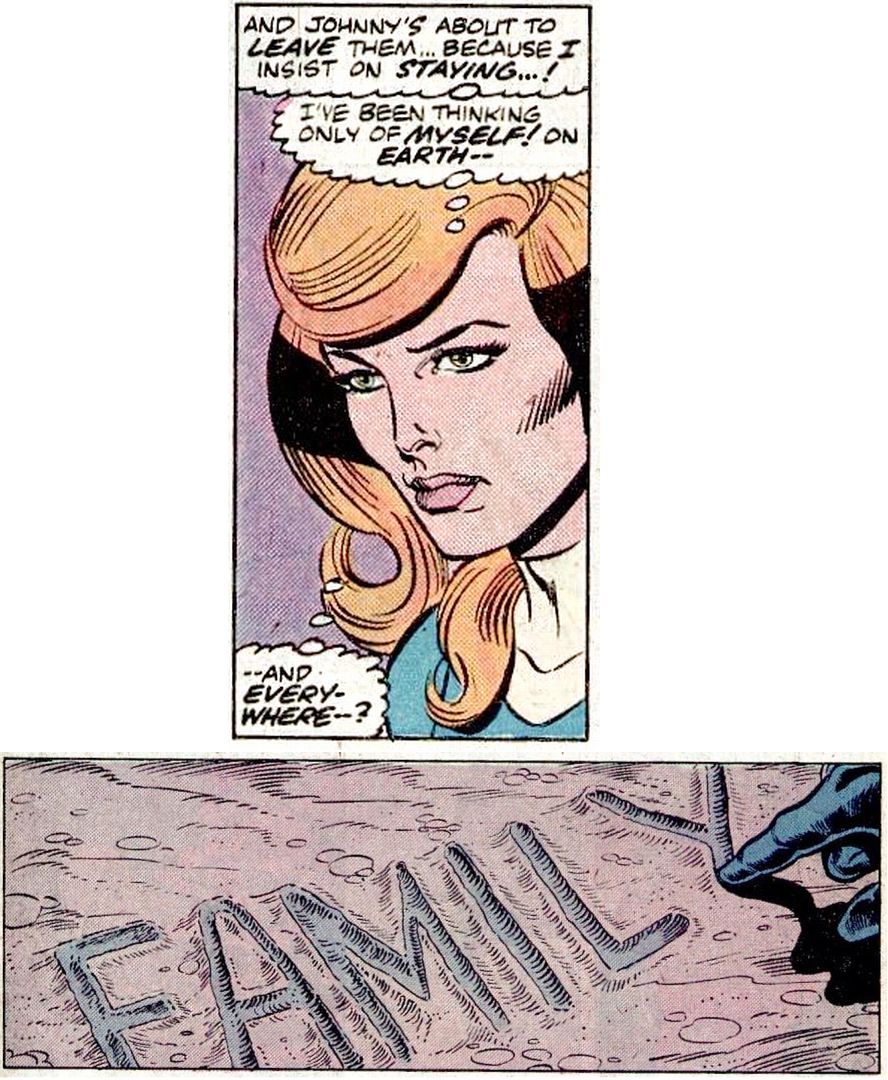
The final annual
This is the final in continuity annual. The next (annual 22) follows directly from FF 333 and is the first adventure
of the clone team (see notes). Every annual in the Great American Novel
has a message of central importance to the whole 28 year story, and the
final annual of course is a message for the future. Or rather, two
messages: an exhortation promise and a warning.
| The 21 annuals As we prepare to finish the Great American Novel, this may be a good moment to remember the message of each of the 21 annuals (21 being the age at which people are traditionally adults: the Great American Novel is about America growing up), In order to reach the number 21, some years do not have annuals. Also, the period of greatest confusion, the end of act 3 and start of act 4, misses four annuals, but later we have four original "giant size Fantastic Four" issues to make up. If I had more time I'd look at the significance of the number four (fantastic four, obviously) and which years missed annuals. But for now, here is a reminder of the main themes covered:
And for good measure, after the story ends and the clone team take over: 22. The clones fight annual 1's battle again (more or less) |
Other points to note
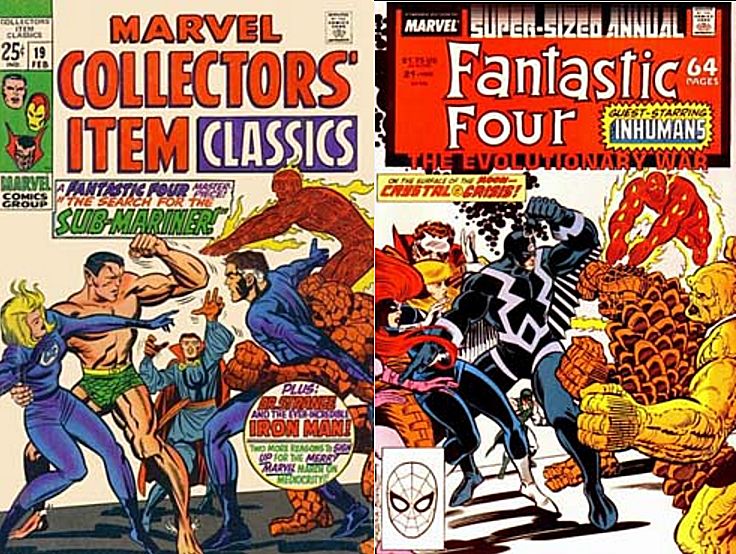
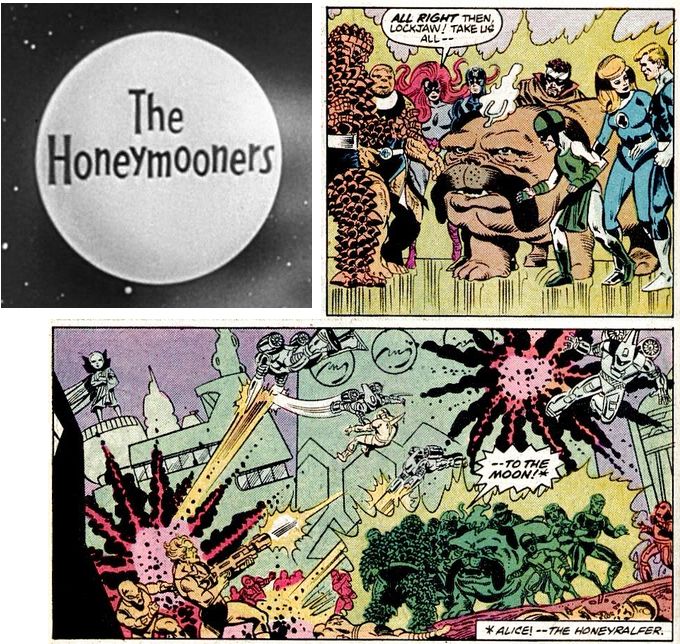
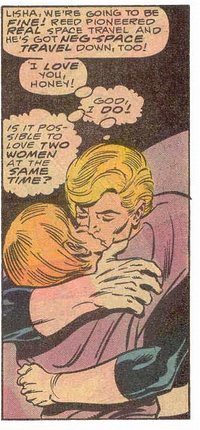
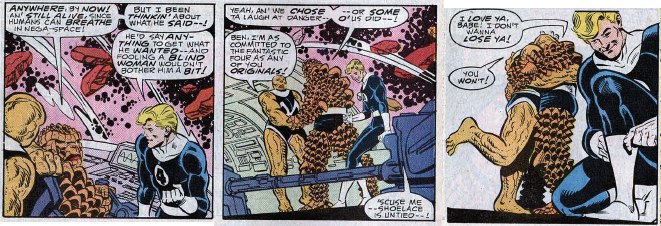
Again this story we see Johnny telling himself that he does love Alicia, he does, he does, he does. But when Alicia says something surprising, Johnny does not believe her, but Ben does. The notable event this issue is Ben's apparent spontaneous declaration of love for Sharon. It may be influenced by Johnny's presence, to reassure him that Ben is not after Alicia. But it could also be simple concern: Ben feels bad that he may be taking Sharon to her death. Whether this is a serious declaration of romantic love or a simple "if we die remember that I love you all" is left for the reader to decide.
A three dimensional Doom
This issue has been criticized because Doom shows a lack of honor in killing the Molecule Man. But Doom is a three dimensional character: a leader who is morally lost when separated from his people. See FF287 and FF312 for other examples. As we see with Sharon, Doom can also do genuine good when it suits his agenda. he is not a two dimensional character.
Doom and Ben
Ben, the one who broke Doom's hands, was always Doom's nemesis: Doom hates Reed, but is far angrier with Ben because Ben is not supposed to be on his level, yet routinely beats him.Doom compensates with high technology, but with Kristoff to keep Doom busy, Ben is now a match for the good doctor.
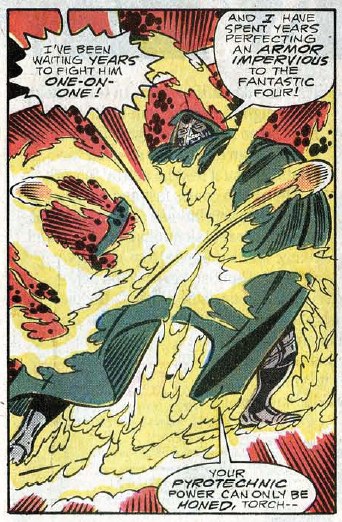
With Reed gone, Doom's future battles will be a lot more physical and more exciting.
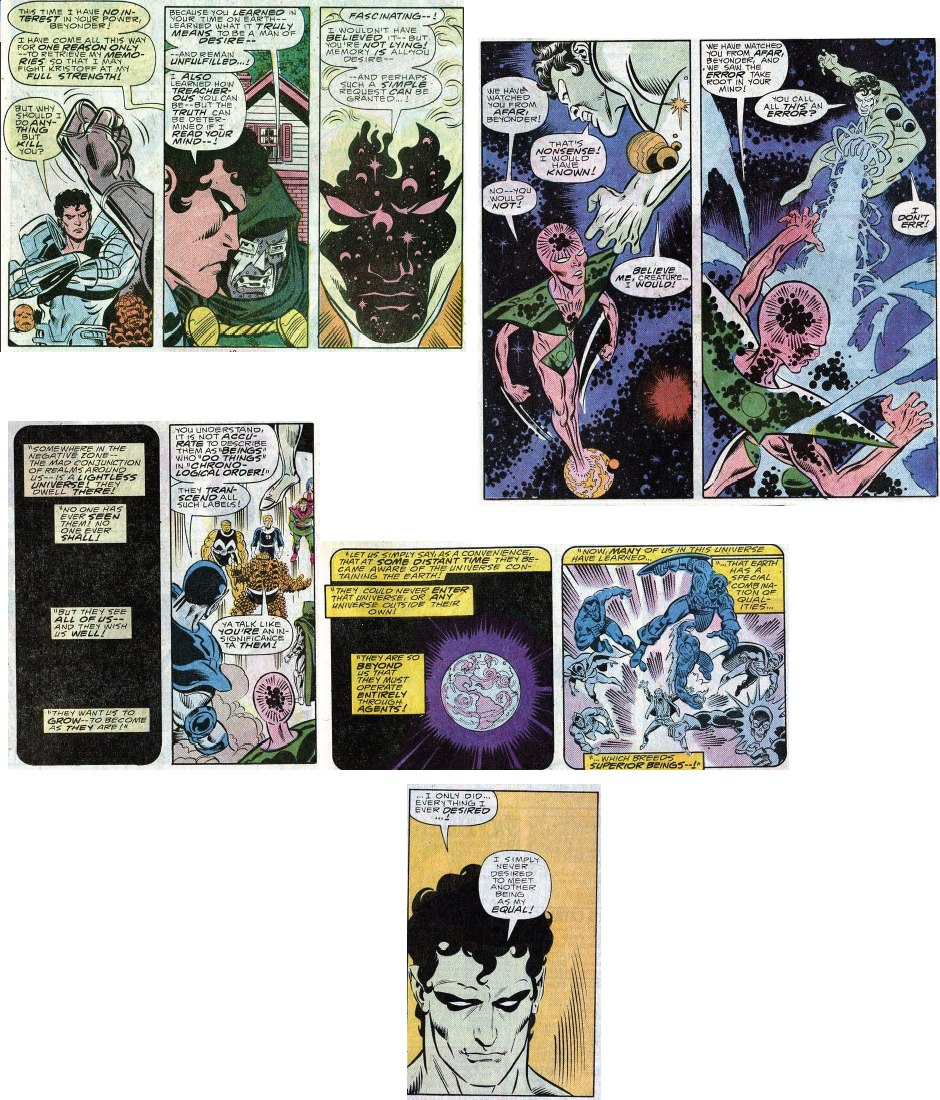
This double sized spectacular finishes the 28 year story with a bang: superpowers are finally explained, and the most powerful being in the Marvel Universe (or so it was believed at the time) is taught humility. He is as great as he thought he was. This parallels Reed's 28 year story: it was all about being humble.
To drive home the parallel, Doom is also not complete, and the important thing he is missing is memory. Memory makes us what we are, it gives us insights and depth. So the loss of memory in the Franklinverse era (when themes can be forgotten and Ben no longer fought in WWII) will be a serious loss.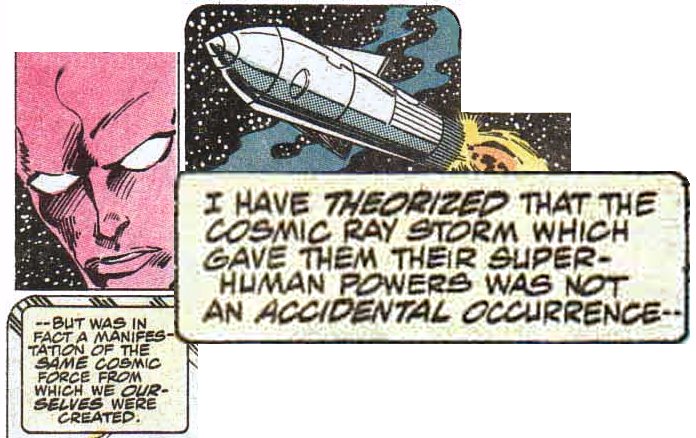
This issue ends the saga of the Molecule Man that began in Act 2 (it was the Molecule Man who made Reed decide to give up being a superhero in FF188, remember). It may also provide what we need to decipher the "accident" in issue 1. Yes, it was a genuine accident, just as the Molecule Man's origin was a genuine accident. But it could only occur because certain powers were waiting. In FF351, Kubik (a star of FF319) makes the link, but all the information is here, in FF319.
More about superpowers, as
explained in FF319.
About the Rick Jones imageOne of the images in FF319 features Rick Jones creating super heroes. This is the defining image from Avengers 97, the key issue in the Kree-Skrull War story. Is this canon? The position of this web site is that non-FF comics are open to exaggeration, since other heroes do not report their adventures direct to Marvel Comics. However, the Kree-Skrull war features strongly in the FF, so it has to be taken seriously. And not just because the Kree and Skrulls first appear in the FF. The Kree-Skrull war is referenced in FF319, the issue that explains everything, and it's the background to FF annuals 12, 15,18 and 19. FF annuals only cover major events, so that gives you an idea of the war's importance. Avengers 97 features Annihilus and the four skrulls from FF2, and what happens reveals a lot about Franklin Richards.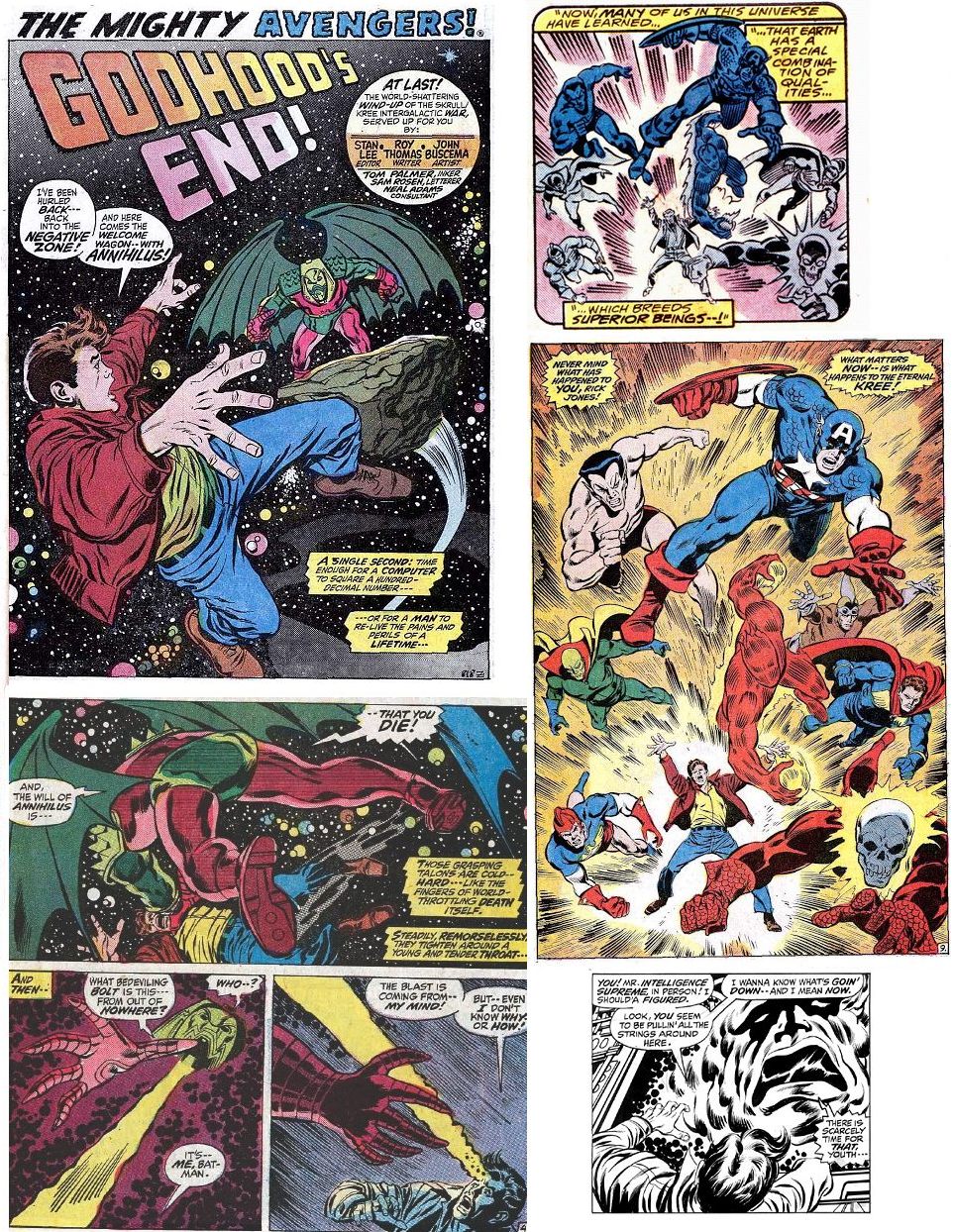 Note that the Avengers title, "Godhood's end" is a
confirmation of FF319. It's a reference to the book "Childhood's
end", the basis of FF245 where Franklin finally took
action (see the notes to FF245). Franklin is both a god (he controls
everything) and a child (he does not understand). The theme of the book "Childhood's End" is the theme of FF319: advanced
aliens are waiting until we are ready for their gifts. In
the advanced aliens are called Beyonders, and the first
gift is super powers to a select few humans. The Fantastic
Four are the first humans to receive such powers (previous
heroes, the Torch and Namor, are not entirely human). One
of their roles is to prepare the way for Franklin, a
living Cosmic Control rod. In Avengers 97 Rick Jones gains a fraction of Franklin's
"Cosmic Control" power, but Rick lacked Franklin's
parentage so could not retain it. The full story was
pieced together by Tony, creator of the amazing "Original
Marvel Universe" (OMU) blog. His email is reprinted
here by kind permission. Franklin Richards, Rick Jones, and the Cosmic Control Rod? I’ve been looking more closely at Rick Jones and his experience in the Kree-Skrull War, and I’ve found something interesting that I think ties in really well with your discussion of Franklin Richards and his relationship with Annihilus, the Cosmic Control Rod, and the Negative Zone. While looking online for some color scans of panels from these stories, I of course stopped by the SuperMegaMonkey Marvel Comics Chronology site. In his extensive review/summary of the storyline, he makes a good point about the climax in which Rick generates simulacra of Golden-Age superheroes to fight Ronan’s troops: “There's no real good explanation about how Rick was able to do what he did or why that power subsequently goes away.” But I think, as is often the case, the answer is literally staring us in the face—it’s right there in the artwork. In AVENGERS #96, Rick Jones is imprisoned on the planet Hala with the Supreme Intelligence, who is, of course, taking credit as the prime mover behind all recent events. (He always does that!) Suddenly, a space warp opens up in the room, which pulls Rick back into the Negative Zone, where Annihilus just happens to be cruising by on an asteroid. The immediate implication is that the Supreme Intelligence created the space warp, but this turns out not to be quite the case. (The space warp actuates from Captain Marvel trying to contact Rick with the Omni-Wave Projector he has just built on the Skrull Throneworld. The Omni-Wave Projector is essentially a communications device that works through subspace, thus allowing instantaneous two-way communication across intergalactic distances. However, the OWP can also be adapted to serve as a powerful weapon, some kind of “ultimate death-ray.” So, while the Supreme Intelligence manipulated events to get Mar-Vell to ‘accidentally’ transport Rick into the Negative Zone just then, he didn’t actively create the space warp himself. And we both know the complicated connections between “subspace” and the Negative Zone.) Now here’s the good bit. In AVENGERS #97, Annihilus attacks Rick and is about to throttle him when suddenly a blast of energy of some kind apparently shoots out of Rick’s mind (through his forehead) and strikes Annihilus—where?—right in the COSMIC CONTROL ROD. Now, this energy beam obviously would be traveling essentially at the speed of light, like the beam of a flashlight, so it would be impossible to see if it actually went from Rick to Annihilus or from Annihilus to Rick. And if there was some kind of two-way transmission going on, neither of them would be able to tell the difference. Annihilus merely says, “What bedeviling bolt is this—from out of nowhere? Who—?” Rick responds, “It’s—me, Bat-Man. The blast is coming from—my mind! But—even I don’t know why—or how!” Note Rick’s hesitation and uncertainty. The next two panels have captions that tell us, “Speechless with shock and useless rage, Annihilus is sent swiftly, violently, hurtling away—till he is lost in darkness and vast distance—leaving a floating and helpless Rick Jones no better off than he was before—and perhaps much worse!” Annihilus does not return, but Rick suddenly has the ability to escape from the exploding atmosphere of the zone of distortion by simply flying away like Superman—“doing the up, up, and away shtick,” as Rick puts it. He then, unconsciously it seems, creates a space warp that takes him right back to the Supreme Intelligence on Hala. The Supreme Intelligence knows that Rick has now achieved the cosmic potential inherent in the human race, and therefore has the power to defeat Ronan and stop the war. It is the Supreme Intelligence who tells Rick what to do next, to concentrate on the superheroes he read about in comic books as a child. As Ronan’s troops rush in to kill their prisoners, Rick suddenly creates his Golden-Age superheroes “out of thin air.” These manifestations appear to have the personalities, memories, and even self-awareness of the originals for the few minutes of their existence. Then, they fade away before Ronan and his troops are fully defeated. Has Rick failed? The Supreme Intelligence tells him, “Your mindlings gave you a moment’s respite, during which your brain could consolidate its awesome, newfound power. Now, however, comes the fateful test!” The creation of these superheroes, which is what everyone remembers and talks about, was not the main event. It was just Rick getting warmed up. Next, he sends out his power in an energy bolt that “fills both chamber and cosmos in the selfsame instant! It permeates the very universe in the space of a heartbeat—reaches the far-off Skrull galaxy,” where it causes every Kree and Skrull involved in the battle to freeze in his tracks, essentially thrown into suspended animation for at least a few minutes. Once this is accomplished, Rick stays on his feet long enough to hear another of the Supreme Intelligence’s long-winded speeches, then pitches over on the brink of death. His frail human form was not able to channel that much cosmic power in such a short amount of time. (Very similar to the DOCTOR WHO episode, if you watch that, where Rose Tyler goes all “Phoenix” on the Daleks and then collapses for the same reason. I know Russell T. Davies was a fan of Marvel Comics from way back, and I’ve always been struck by the many apparent borrowings in DOCTOR WHO from old comic book story lines and tropes. The Face of Boe is reminiscent of the Supreme Intelligence, for example. But that’s a whole other tangent.) So essentially, Rick has a close encounter with Annihilus’s Cosmic Control Rod, then manifests these awesome cosmic powers to warp reality, and burns them out very quickly. I think the Supreme Intelligence’s whole plan was for Rick to absorb the power of the Cosmic Control Rod and use it to stop the “hot” war between the two empires, so they would settle back into their comfortable and more manageable “cold” war status quo. Rick absorbed a set amount of its energy, which enabled him to do what needed to be done, and then the energy was all expended, leaving him “uncursed by awakening of latent power,” as the S.I. says while teleporting Rick and the Avengers back to earth. That’s why he never manifested such abilities again. Rick’s life is saved when Captain Marvel phases into him, providing Rick with the “life force” he needs to continue to exist. However, Rick and Captain Marvel were separated again years later, with no ill effects on Rick, so clearly Rick just needed the “life force” to sustain him long enough for his body to heal. Annihilus could easily have been driven away not by some kind of mental force-blast, but by the draining of energy from the Cosmic Control Rod. The comic does not clearly explain what exactly is happening in that scene, and leaves it open to interpretation. Interestingly, when all the Skrulls suddenly stop fighting and go into a trance, the confused Avengers are wondering who caused it. Iron Man says, “Whoever did it, one thing’s for sure—he’s got to be one of the most powerful beings in the universe!” Sounds like hyperbole, but isn’t that how we might describe Franklin Richards? Here, Rick took a short-cut and was artificially amped-up by the Cosmic Control Rod to do exactly what Franklin can do naturally. And of course it almost cost him his life. Unlike Rick, Franklin was an enhanced human already, being a mutant, and was “energized” at birth with the Cosmic Control Rod, as you’ve pointed out. So Franklin is able to channel the same power levels that Rick did without destroying himself. In this way, Rick is something of a precursor to Franklin Richards. This story takes place when Franklin is still basically an infant (whether you’re in real-time, Marvel Time, or my OMU timeline) and his powers have not yet manifested. If you want to put a “biblical” spin on it, you could say that Rick Jones is the “John the Baptist” to Franklin’s “Jesus Christ.” And obviously the Supreme Intelligence is analogous to “God” (YHWH, Yahweh, Jehovah, etc.) (I guess that makes Annihilus “Satan” and the Negative Zone is “Hell,” but I think I’m getting way ahead of myself and this analogy is spinning out of control.) Anyway, I think AVENGERS #97 offers a great deal of support for your ideas about the Cosmic Control Rod’s involvement in Franklin’s birth and the nature of his mutant/cosmic powers. -- Tony |
Ben is happy at last
In case it was not obvious, this issue makes it explicit:
Ben no longer wants to change back.
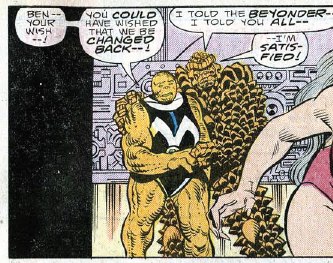
The epic story ends
And so FF319 ends. With a story of reluctance and equality
(and confidence, and getting what they want; all the themes
are here), all the themes from the 28 years are complete. All
the major sub plots are complete. Everything past here is
an appendix: tying up loose ends (exspecially showing Reed
happy at last), warnings for future writers (the clone team), and a
prelude to the next story.
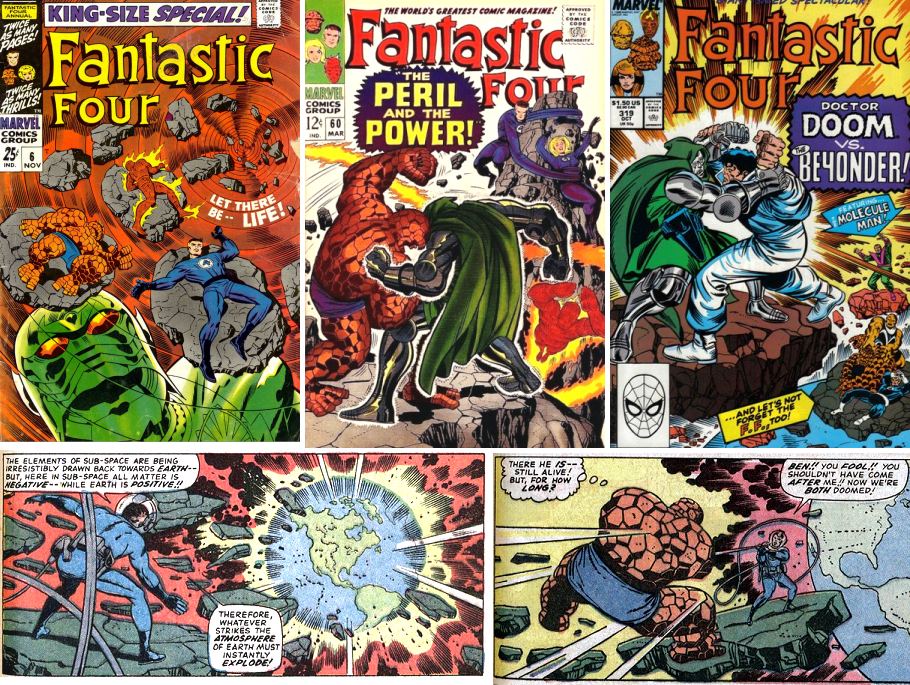
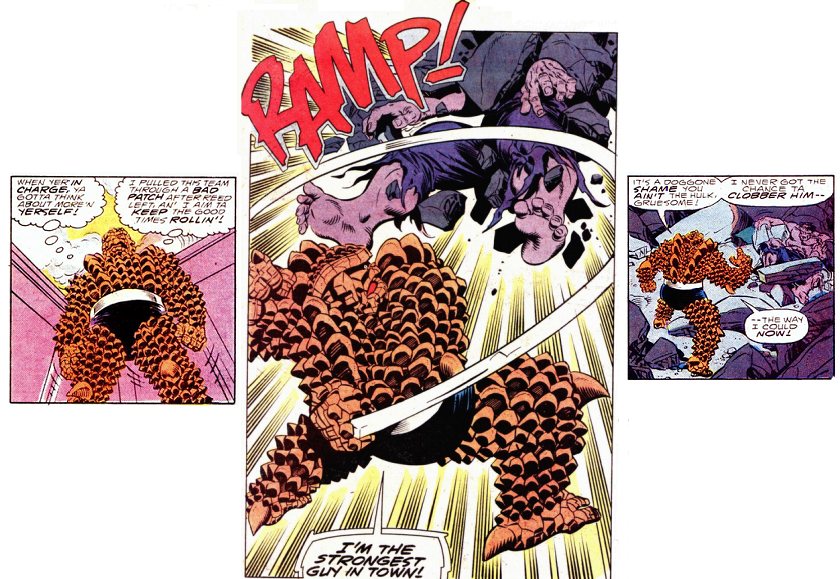
Finally a conclusion to the age-old Hulk Versus Thing war. After 28 years, the Thing finally wins! And to symbolize the new equality in the book, the next issue has She-Hulk versus She-Thing.
Note Doctor Doom on the cover: Doom is now Ben's opponent, not Reed's. Doom may consider Reed's semi-retirement as either Reed admitting defeat, or Reed arrogantly saying that even Ben could defeat him now. Which is true: Doom is now rescued to a threat he can deal on his own. And note Doom's hands outstretched: Ben gave him arguably his greatest humiliation by crushing his hands. It is doubtful whether hands with that much damage could ever fully recover their original state. 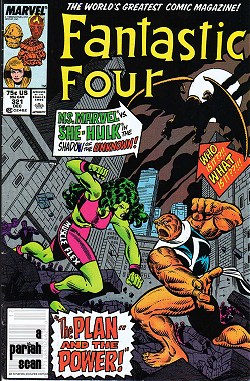
Issue 321 is the last in-continuity monthly issue of the Fantastic Four. That is, the last one where all events grow out of previous events. Note the retro-style cover, looking back to several classic covers of the past. There was then a limbo period, during which events did not move forwards, but did not move dramatically backwards either. For much of this period the team were literally asleep. This limbo period ended with issue 354: see further down the page. At the end of 354 the team was dramatically rebooted. It is possible that some later issues may or may not be in continuity, depending on how we view Franklin's role.
This issue sums up the state of the Fantastic Four at this point: Ben has finally come to terms with himself, and is no longer needy. Johnny is finally facing the decision that will kick start the next generation of the FF (see "The Last Fantastic Four Story" below - note the moon imagery). She-Thing is finally at peace and ready to have fun, and walks into the moonlight with She-Hulk, the previous "new member."
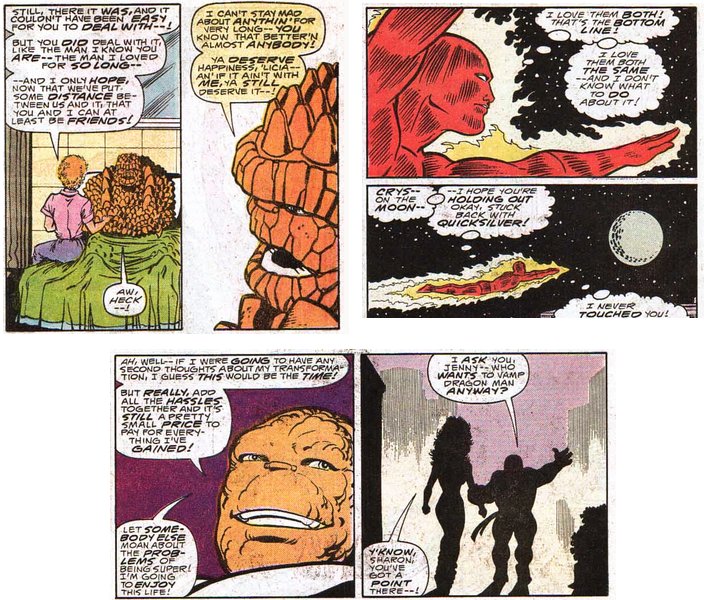
With FF321, the book is finally ready for the future. But
instead, 322 started a break in the story,
and a rather long interlude... 24 years of the Franklinverse, and
counting!
The very first panels of the 28 year story (after the splash page),
shows Sue leaving her friends to join the FF. This is highly symbolic.
What follows is 28 years of chaos driven by the men: 28 years of
fighting, confrontation and struggle.
28 years later, the women finally decide to do things their way. They
decide that their lives do not need to revolve around men. And they walk
off into the sunset.
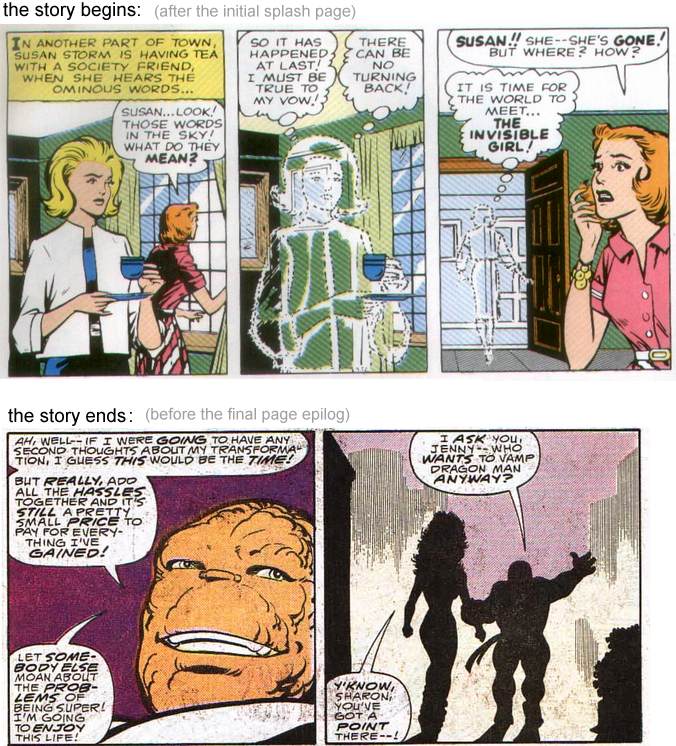
Again and again we have seen that Sue's gentle methods could have
solved
or prevented the problems. But Sue is always kept too busy to sit down
and do things her way, or else she is just ignored. This is all part of
the theme of alienation, discussed in the notes to issue 2.
Sexism is part of the American story, particularly when the story
opened in 1961. Women in the 1950s were supposed to stay at home: with
no income, very little human contact, and no right to overrule men. The
Fantastic Four starts with the race to the moon, and this was as sexist
as anywhere else. In space flight, every pound of weight matters. Women,
being lighter, should have been the obvious astronauts. They were often
better fliers than the men. But instead they were banned:
"Under
NASA's selection criteria women could not qualify as astronaut
candidates. Glenn also believed that "The fact that women are not in
this field is a fact of our social order." They correctly stated that
NASA required all astronauts to be graduates of military jet test
piloting programs and have engineering degrees, although John Glenn
conceded that he had been assigned to NASA's Mercury Project without
having earned the required college degree. In 1962, women were still
barred from Air Force training schools, so no American women could
become test pilots of military jets. Despite the fact that several of
the Mercury 13 [women] had been employed as civilian test pilots, and
many had considerably more propeller aircraft flying time than the male
astronaut candidates" (Wikipedia)
All the women
in the Great American Novel are strong, usually stronger than the men,
but are alienated from the society they would naturally choose:
The Bechdel test: a summary
We can see their alienation by how seldom the women meet and talk:
between those first and last panels they seldom they pass the Bechdel
test: "The Bechdel test asks if a work
of fiction features at least two women who talk to each other about
something other than a man." (Wikipedia) Here
are the main woman-woman conversations in the 28 year Fantastic Four
story. Apart from the very start and very end, they all show alienation
from each other due to conflicts originating with males:
The only time women can pass the Bechdel test without alienation or
conflict is the very opening and closing panels of the story. The story
is about male conflict as it affects the females around them.
Men, women and Watchers
Incidentally, note the presence of the rogue Watcher. In Genesis 6 and
the book of Enoch, the watchers were the Nephilim, the offspring of
forbidden liaisons between the sons of god and the daughters of men.
This forbidden male-female mixing
was followed by the calamity of the Great Flood. the most learned of
the early Christians ("gnostic" means "learned") argued that at this
point these gods were corrupt, and Noah's wife (Norea) was the smart one
(she was Sophia, spirit of wisdom). Draw whatever parallels you want!
Who is Aron?This is a shortened version of much longer notes. I don't have the time to do this topic justice: it links everything. but hopefully these short comments are better than nothing. The opposite of a Watcher
Is he a villain? How could he not be the real Aron? And another problem: So the weakest and most rebellious Watcher, Aron would be very sympathetic to a Dragon Rider's requests. And if a Dragon Rider wanted to hide then pretending to be a Watcher would be a good idea: that way, no matter what crazy powers the Dragon Rider uses, nobody would think it was odd. But still, why would Ral Dorn want to hide his identity? Let's see what we know about Ral Dorn. Ral Dorn's need for a disguise
Ral Dorn's father Checking this conclusion 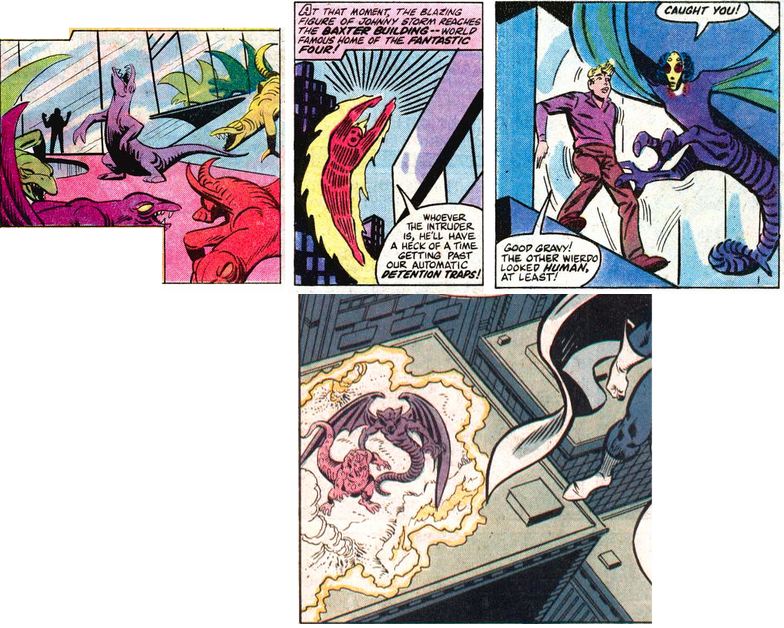 TO BE CONTINUED! Coming soon: Who began Inferno, and what is their link with the Dragon Riders? Who was Necrodamus originally, and why would the Dragon Riders be so impressed? Questions answered, and how Dragon man ties everything together. |
And so we come to the end of the Great American novel. What next
for America? The big new idea introduced here is the Rogue
Watcher: as the lone superpower America is no longer limited and
can survey the whole world and do what it wants. Or so it thinks..
